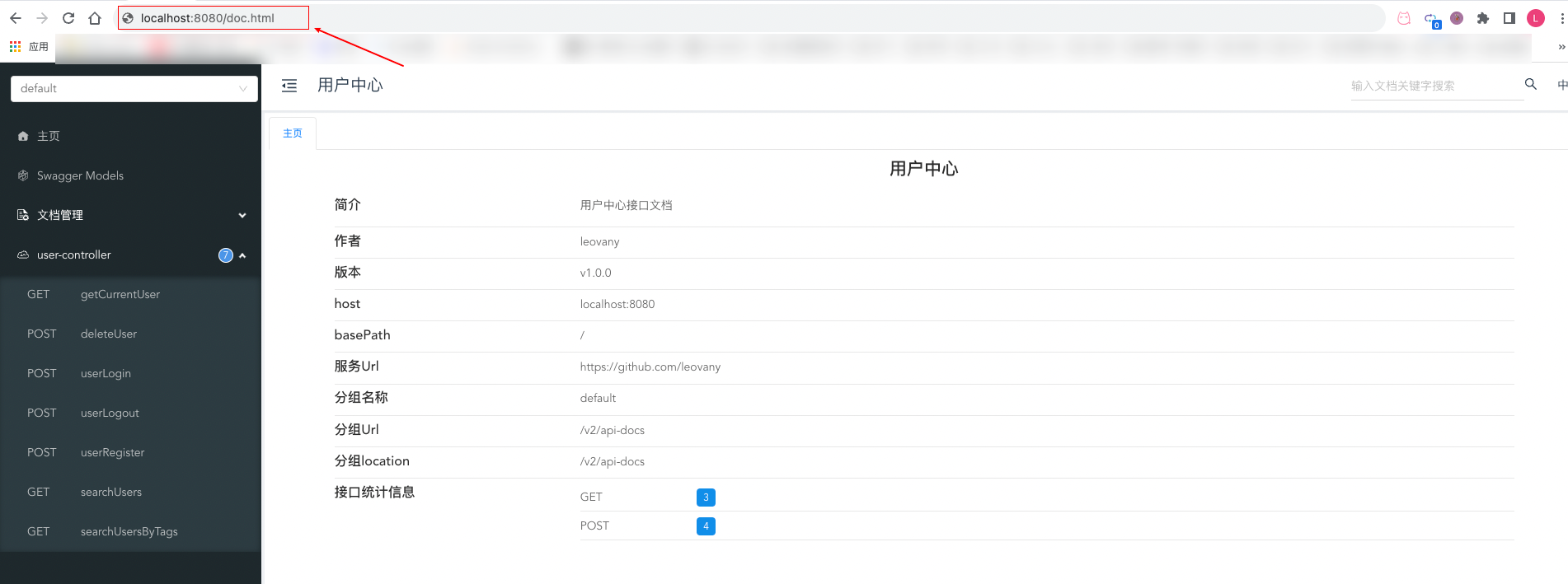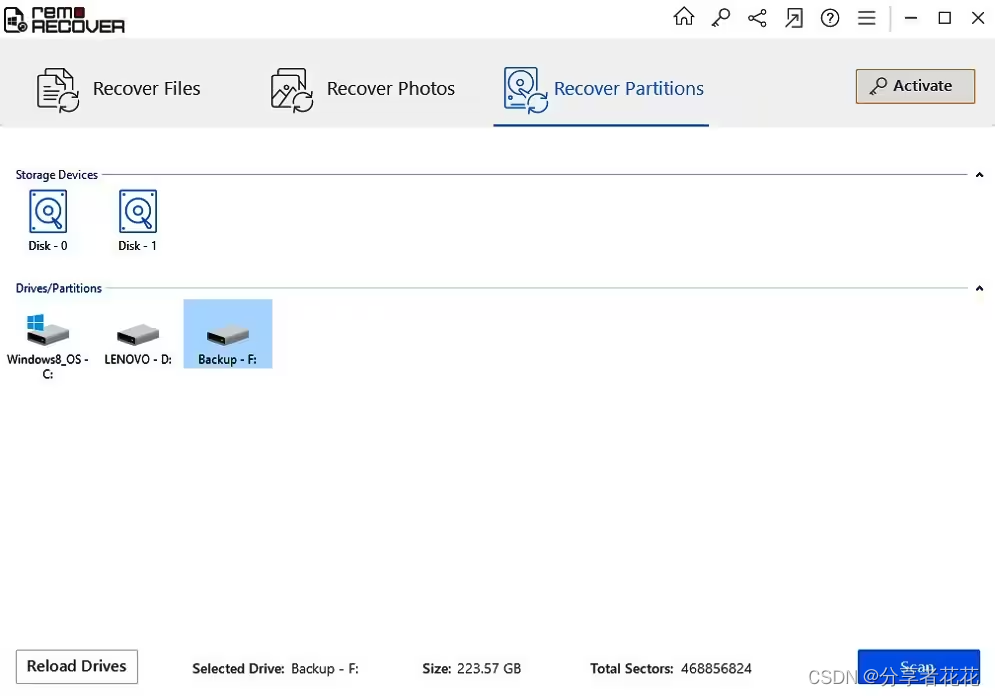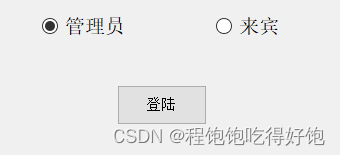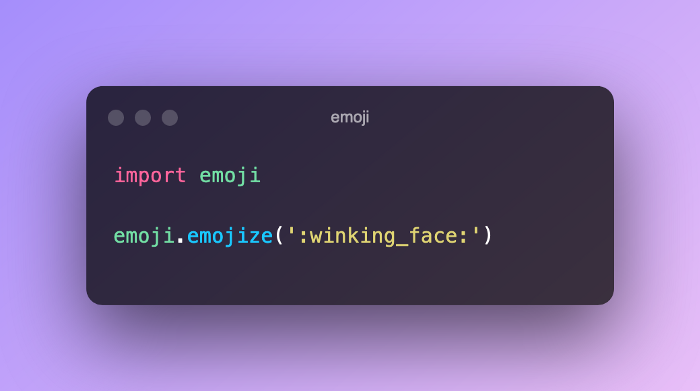1、JdbcTemplate
Spring 框架对 JDBC 进行封装,使用 JdbcTemplate 方便实现对数据库操作

1.1 准备工作
①搭建子模块
搭建子模块:spring-jdbc-tx
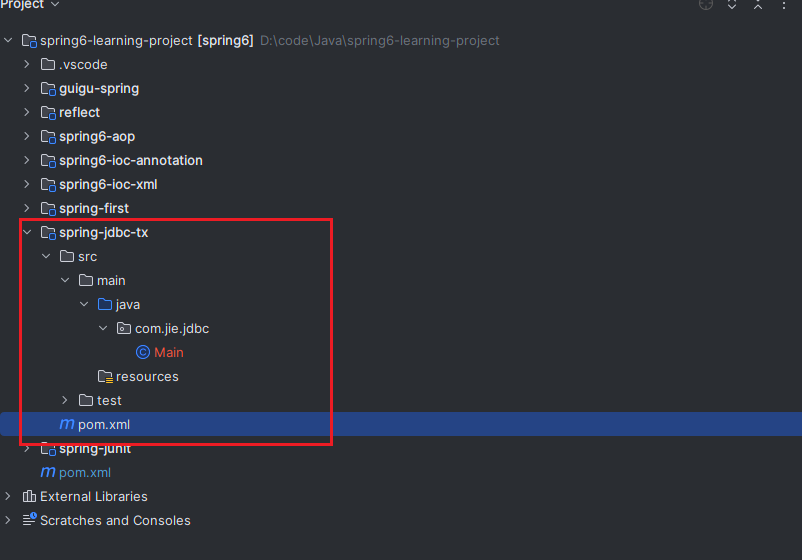
②加入依赖
<dependencies>
<!--spring jdbc Spring 持久化层支持jar包-->
<dependency>
<groupId>org.springframework</groupId>
<artifactId>spring-jdbc</artifactId>
<version>6.0.2</version>
</dependency>
<!-- MySQL驱动 -->
<dependency>
<groupId>mysql</groupId>
<artifactId>mysql-connector-java</artifactId>
<version>8.0.30</version>
</dependency>
<!-- 数据源 -->
<dependency>
<groupId>com.alibaba</groupId>
<artifactId>druid</artifactId>
<version>1.2.15</version>
</dependency>
<!--spring test Spring 测试jar包-->
<dependency>
<groupId>org.springframework</groupId>
<artifactId>spring-test</artifactId>
<version>6.0.9</version>
<scope>test</scope>
</dependency>
<!--junit5-->
<dependency>
<groupId>org.junit.jupiter</groupId>
<artifactId>junit-jupiter</artifactId>
<version>RELEASE</version>
<scope>test</scope>
</dependency>
<!--spring tx Spring 事务管理jar包-->
<dependency>
<groupId>org.springframework</groupId>
<artifactId>spring-context</artifactId>
<version>6.0.11</version>
</dependency>
</dependencies>
③创建jdbc.properties
jdbc.user=root
jdbc.password=root
jdbc.url=jdbc:mysql://localhost:3306/spring?characterEncoding=utf8&useSSL=false
jdbc.driver=com.mysql.cj.jdbc.Driver
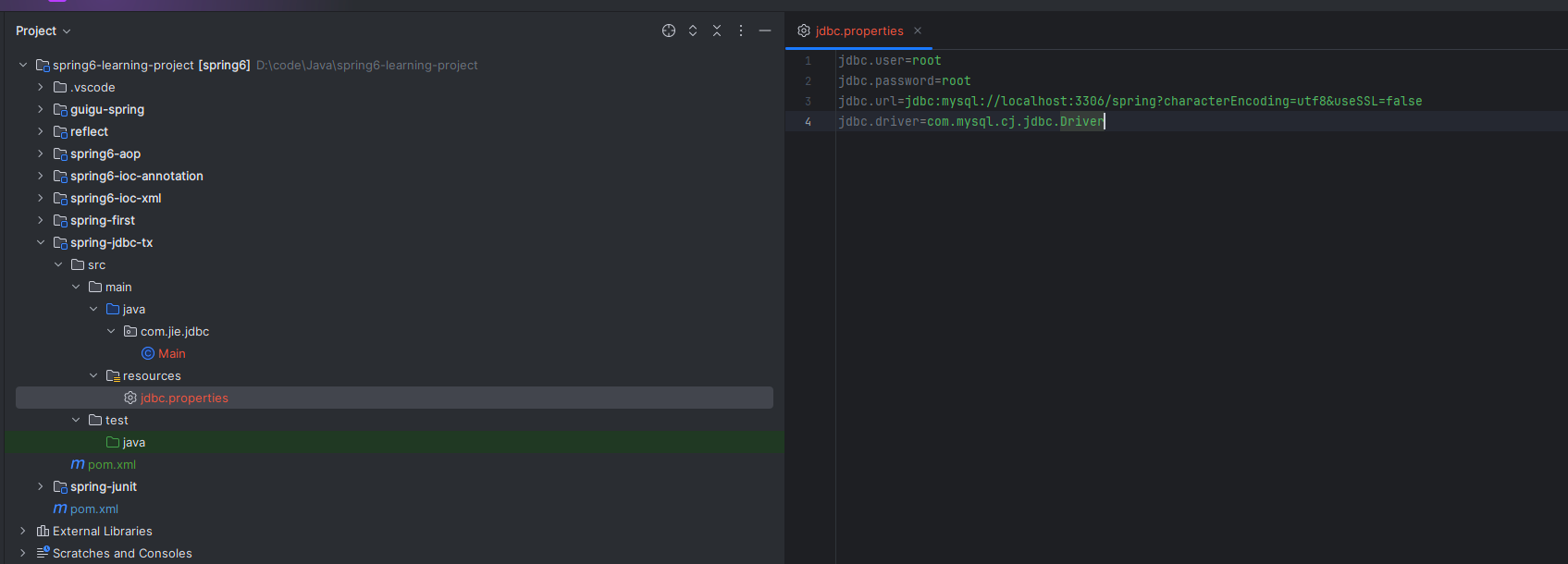
④配置Spring的配置文件
beans.xml
<?xml version="1.0" encoding="UTF-8"?>
<beans xmlns="http://www.springframework.org/schema/beans"
xmlns:xsi="http://www.w3.org/2001/XMLSchema-instance"
xmlns:context="http://www.springframework.org/schema/context"
xsi:schemaLocation="http://www.springframework.org/schema/beans
http://www.springframework.org/schema/beans/spring-beans.xsd
http://www.springframework.org/schema/context
http://www.springframework.org/schema/context/spring-context.xsd">
<!-- 导入外部属性文件 -->
<context:property-placeholder location="classpath:jdbc.properties" />
<!-- 配置数据源 -->
<bean id="druidDataSource" class="com.alibaba.druid.pool.DruidDataSource">
<property name="url" value="${jdbc.url}"/>
<property name="driverClassName" value="${jdbc.driver}"/>
<property name="username" value="${jdbc.user}"/>
<property name="password" value="${jdbc.password}"/>
</bean>
<!-- 配置 JdbcTemplate -->
<bean id="jdbcTemplate" class="org.springframework.jdbc.core.JdbcTemplate">
<!-- 装配数据源 -->
<property name="dataSource" ref="druidDataSource"/>
</bean>
</beans>
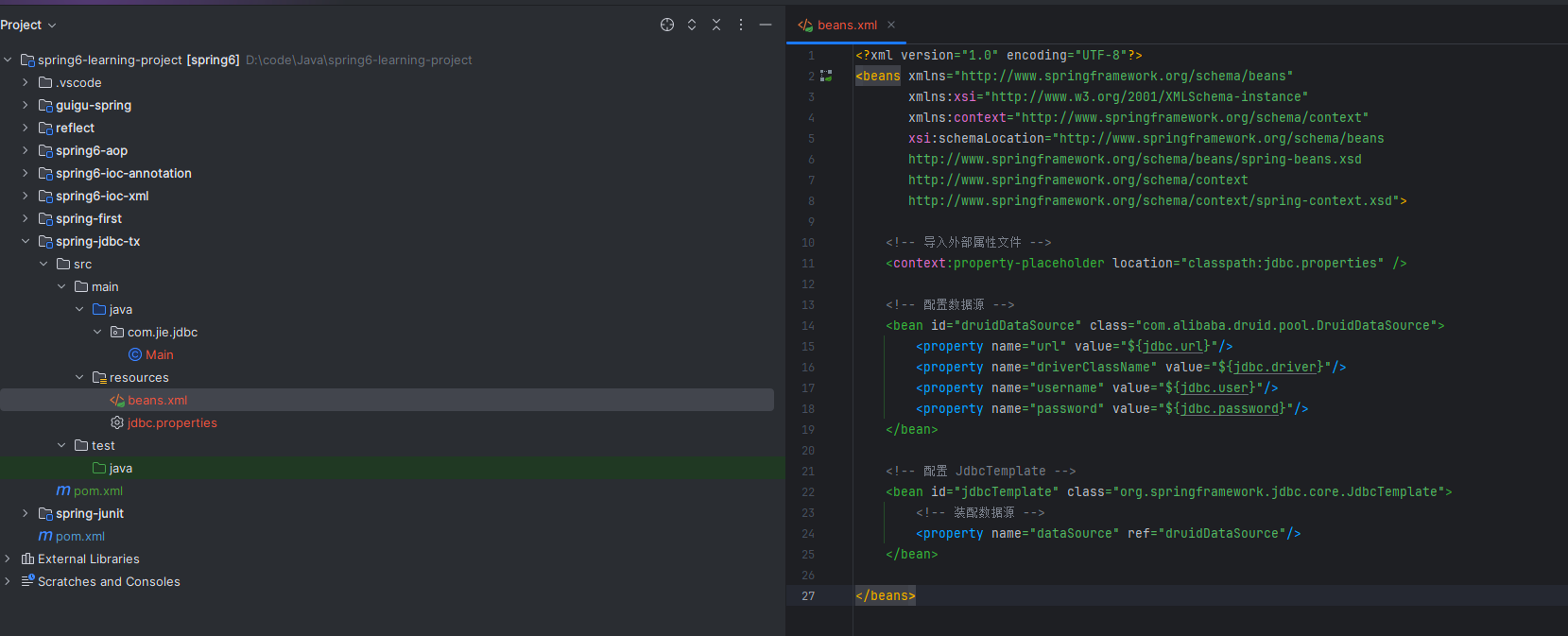
⑤准备数据库与测试表
CREATE DATABASE `spring`;
use `spring`;
CREATE TABLE `t_emp` (
`id` int(11) NOT NULL AUTO_INCREMENT,
`name` varchar(20) DEFAULT NULL COMMENT '姓名',
`age` int(11) DEFAULT NULL COMMENT '年龄',
`sex` varchar(2) DEFAULT NULL COMMENT '性别',
PRIMARY KEY (`id`)
) ENGINE=InnoDB DEFAULT CHARSET=utf8mb4;
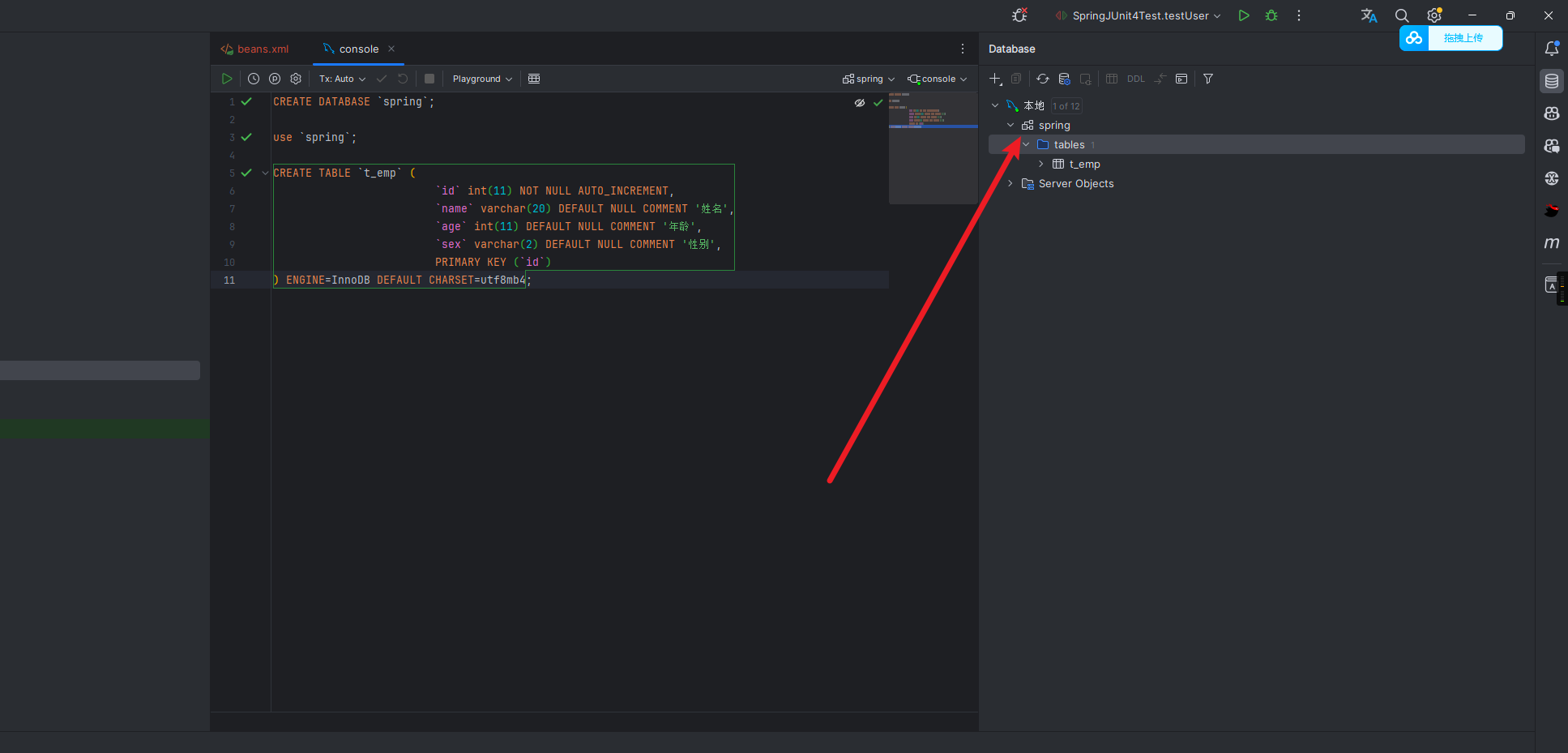
1.2 实现CURD
①装配 JdbcTemplate
创建测试类,整合JUnit,注入JdbcTemplate
package com.atguigu.spring6;
import org.springframework.beans.factory.annotation.Autowired;
import org.springframework.jdbc.core.JdbcTemplate;
import org.springframework.test.context.junit.jupiter.SpringJUnitConfig;
@SpringJUnitConfig(locations = "classpath:beans.xml")
public class JDBCTemplateTest {
@Autowired
private JdbcTemplate jdbcTemplate;
}
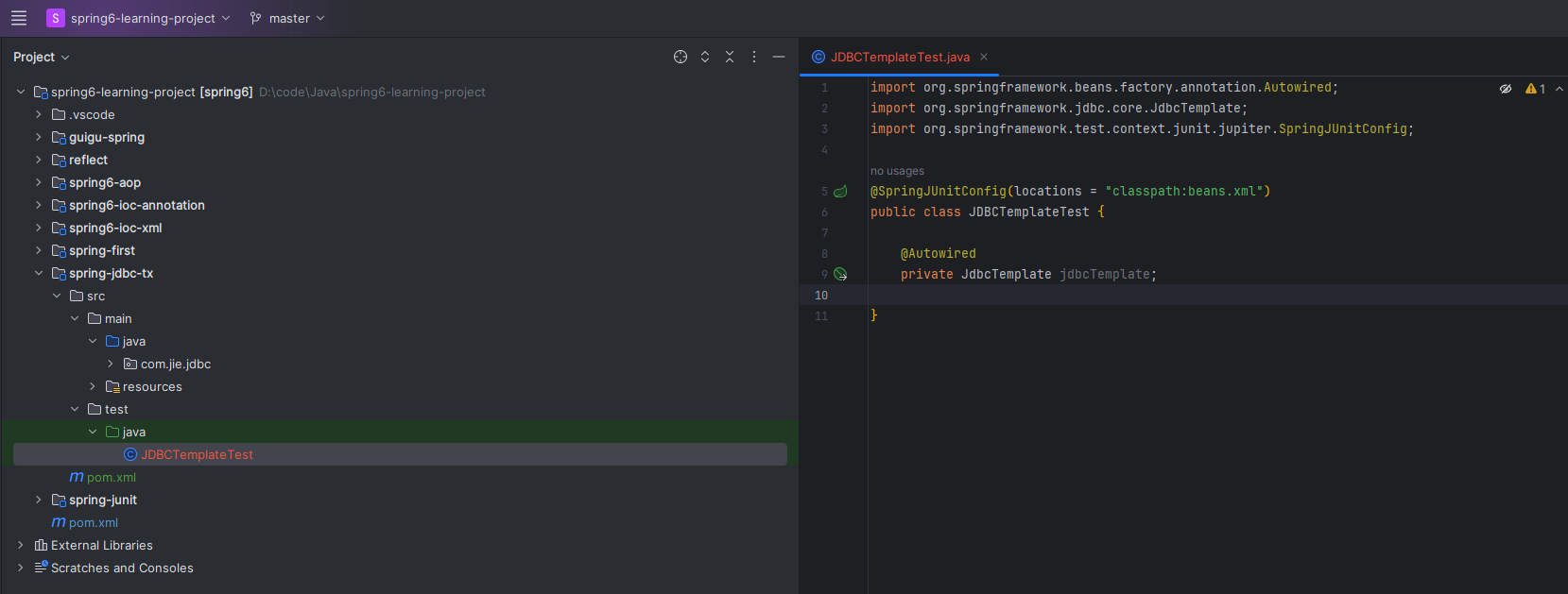
②测试增删改功能
@Test
public void testUpdate() {
//添加功能
String sql = "insert into t_emp values(null,?,?,?)";
// 执行sql
int result = jdbcTemplate.update(sql, "张三", 23, "男");
// 断言
assert result == 1;
//修改功能
//String sql = "update t_emp set name=? where id=?";
//int result = jdbcTemplate.update(sql, "张三atguigu", 1);
//删除功能
//String sql = "delete from t_emp where id=?";
//int result = jdbcTemplate.update(sql, 1);
}
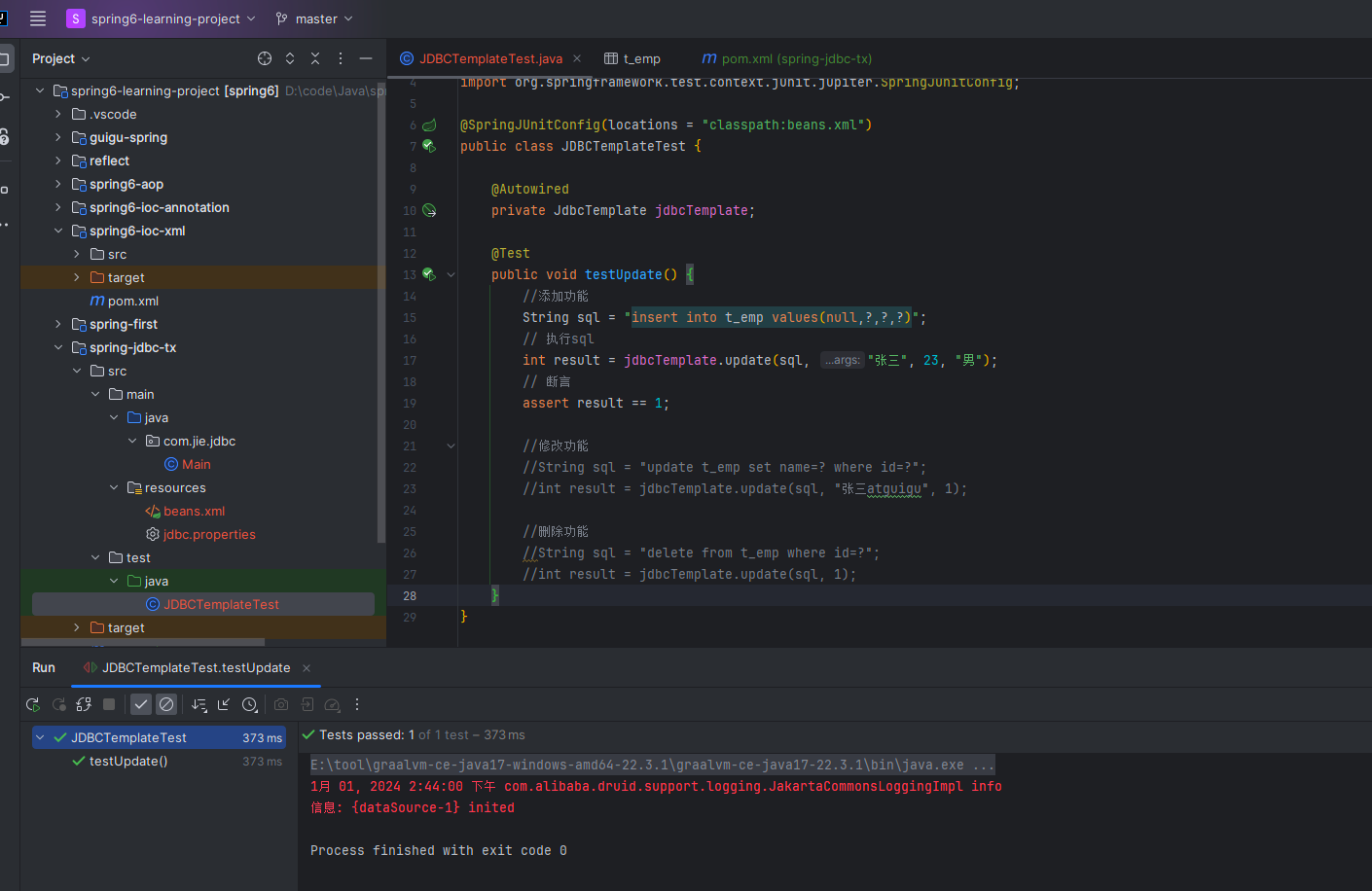

③查询数据返回对象
package com.jie.jdbc.model;
/**
* TODO
*
* @author 阿杰 2416338031@qq.com
* @date 2024/1/1 14:50
* @version 1.0
*/
public class Emp {
private Integer id;
private String name;
private Integer age;
private String sex;
public Integer getId() {
return id;
}
public void setId(Integer id) {
this.id = id;
}
public String getName() {
return name;
}
public void setName(String name) {
this.name = name;
}
public Integer getAge() {
return age;
}
public void setAge(Integer age) {
this.age = age;
}
public String getSex() {
return sex;
}
public void setSex(String sex) {
this.sex = sex;
}
@Override
public String toString() {
return "Emp{" +
"id=" + id +
", name='" + name + '\'' +
", age=" + age +
", sex='" + sex + '\'' +
'}';
}
}
@Test
public void testSelectObject() {
//写法一
// String sql = "select * from t_emp where id=?";
// Emp empResult = jdbcTemplate.queryForObject(sql,
// (rs, rowNum) -> {
// Emp emp = new Emp();
// emp.setId(rs.getInt("id"));
// emp.setName(rs.getString("name"));
// emp.setAge(rs.getInt("age"));
// emp.setSex(rs.getString("sex"));
// return emp;
// }, 1);
// System.out.println(empResult);
//写法二
String sql = "select * from t_emp where id=?";
Emp emp = jdbcTemplate.queryForObject(sql,
new BeanPropertyRowMapper<>(Emp.class),1);
// 断言
assert emp != null;
System.out.println(emp);
}

④查询数据返回list集合
@Test
//查询多条数据为一个list集合
public void testSelectList(){
String sql = "select * from t_emp";
List<Emp> list = jdbcTemplate.query(sql, new BeanPropertyRowMapper<>(Emp.class));
System.out.println(list);
}
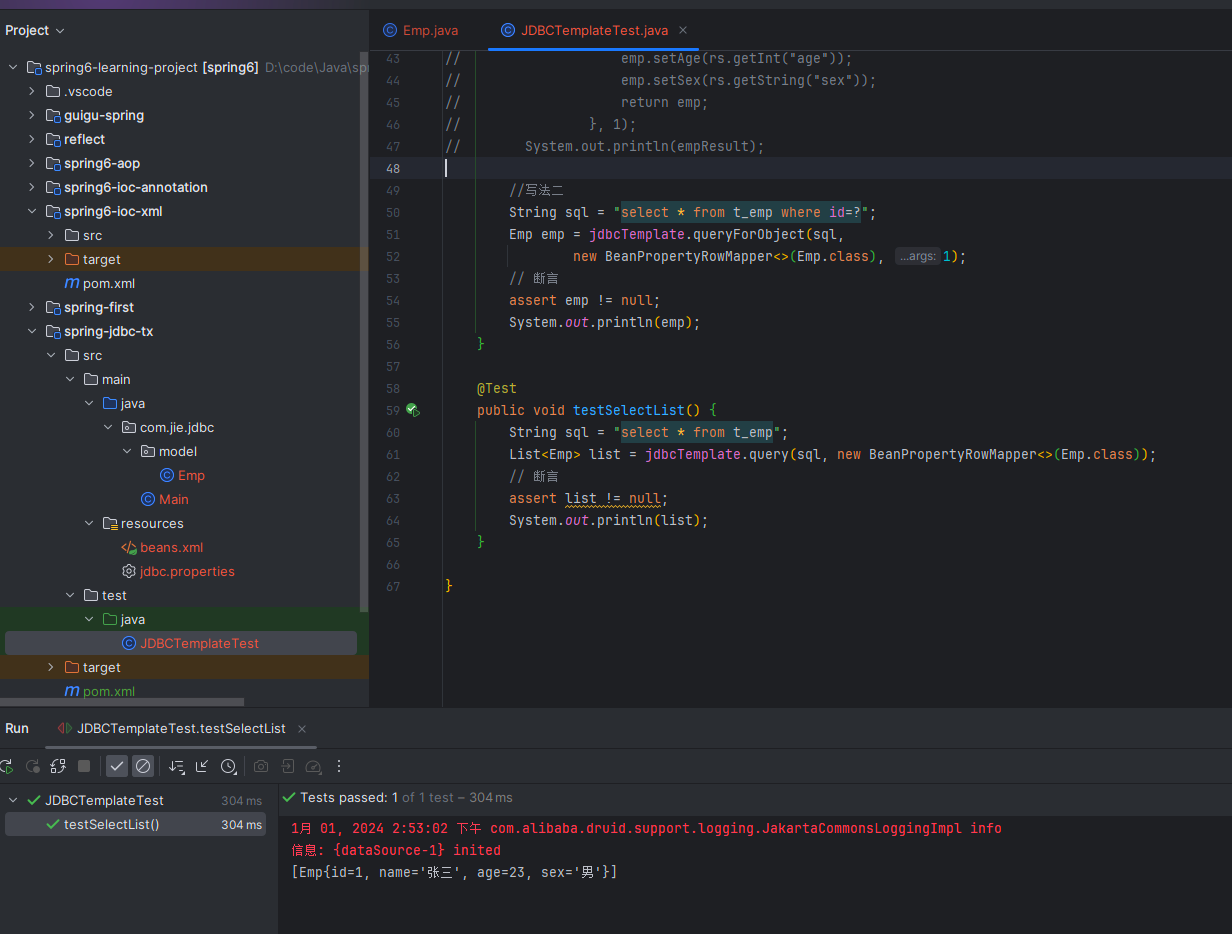
⑤查询返回单个的值
@Test
//查询单行单列的值
public void selectCount(){
String sql = "select count(id) from t_emp";
Integer count = jdbcTemplate.queryForObject(sql, Integer.class);
System.out.println(count);
}
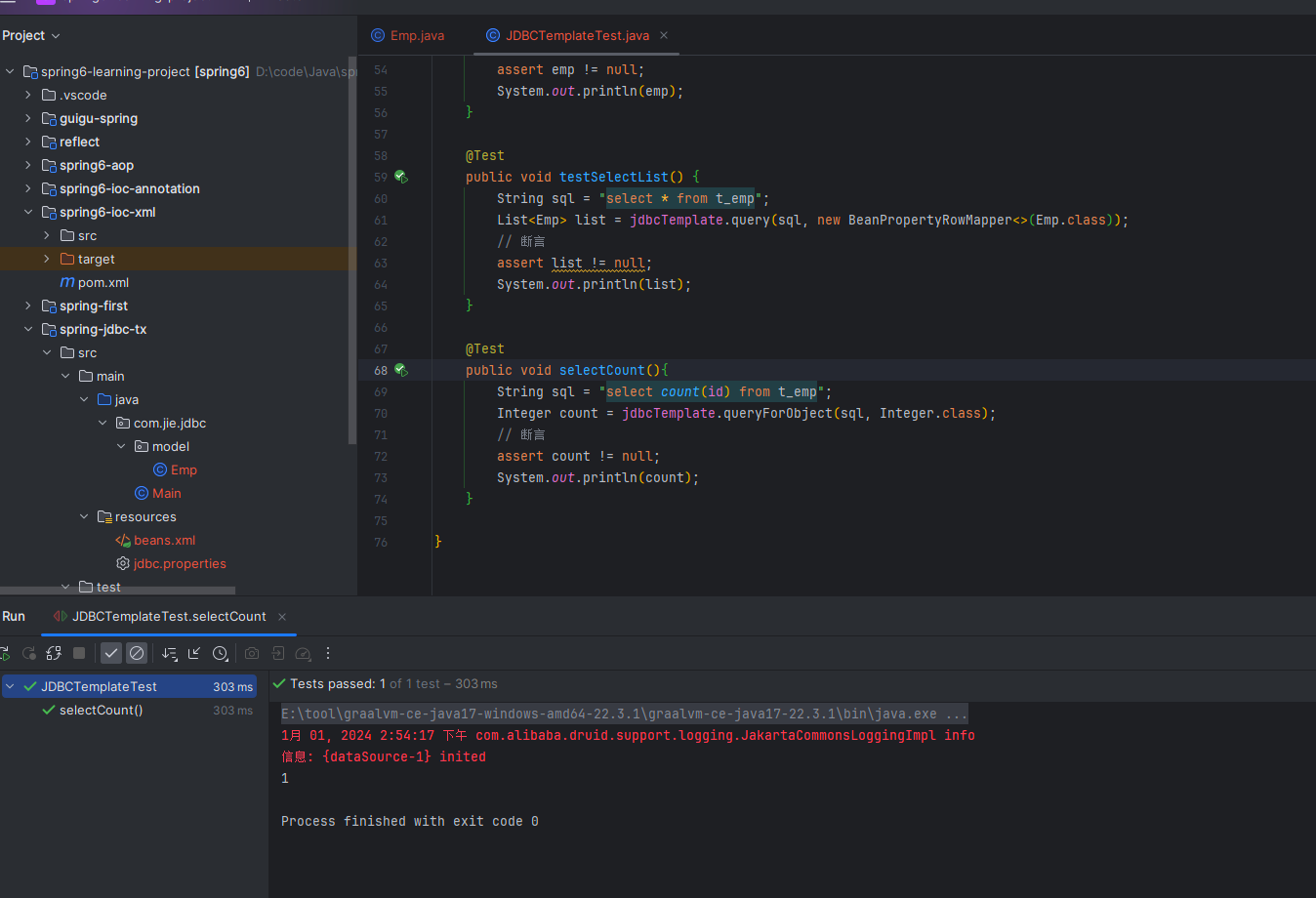
2、声明式事务
2.1 事务基本概念
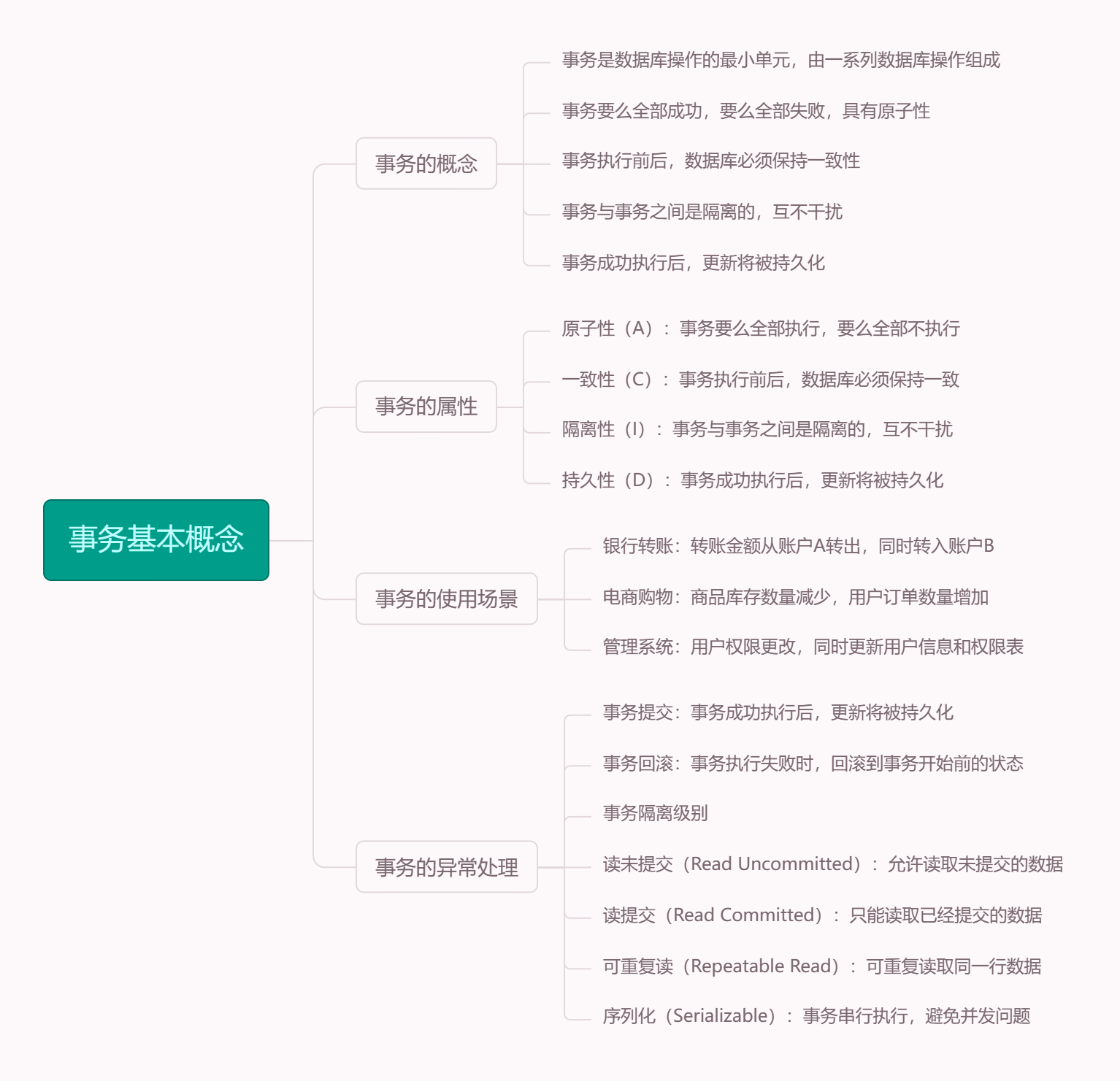
2.2 编程式事务
编程式指的就是我们用代码方式来自己实现事务。
Connection conn = ...;
try {
// 开启事务:关闭事务的自动提交
conn.setAutoCommit(false);
// 核心操作
// 提交事务
conn.commit();
}catch(Exception e){
// 回滚事务
conn.rollBack();
}finally{
// 释放数据库连接
conn.close();
}
比如说你现在开启事务、提交事务、回滚事务,这个过程中完全需要手动写代码实现。大家也看到它并不是很方便。
编程式的实现方式存在缺陷:
- 细节没有被屏蔽:具体操作过程中,所有细节都需要程序员自己来完成,比较繁琐。
- 代码复用性不高:如果没有有效抽取出来,每次实现功能都需要自己编写代码,代码就没有得到复用。
2.3 声明式事务
Spring框架提供了声明式事务管理的功能,允许开发者通过配置来定义事务规则,而无需编写大量的事务管理代码。声明式事务是通过Spring的AOP(面向切面编程)来实现的,通常使用注解或XML配置来定义事务。
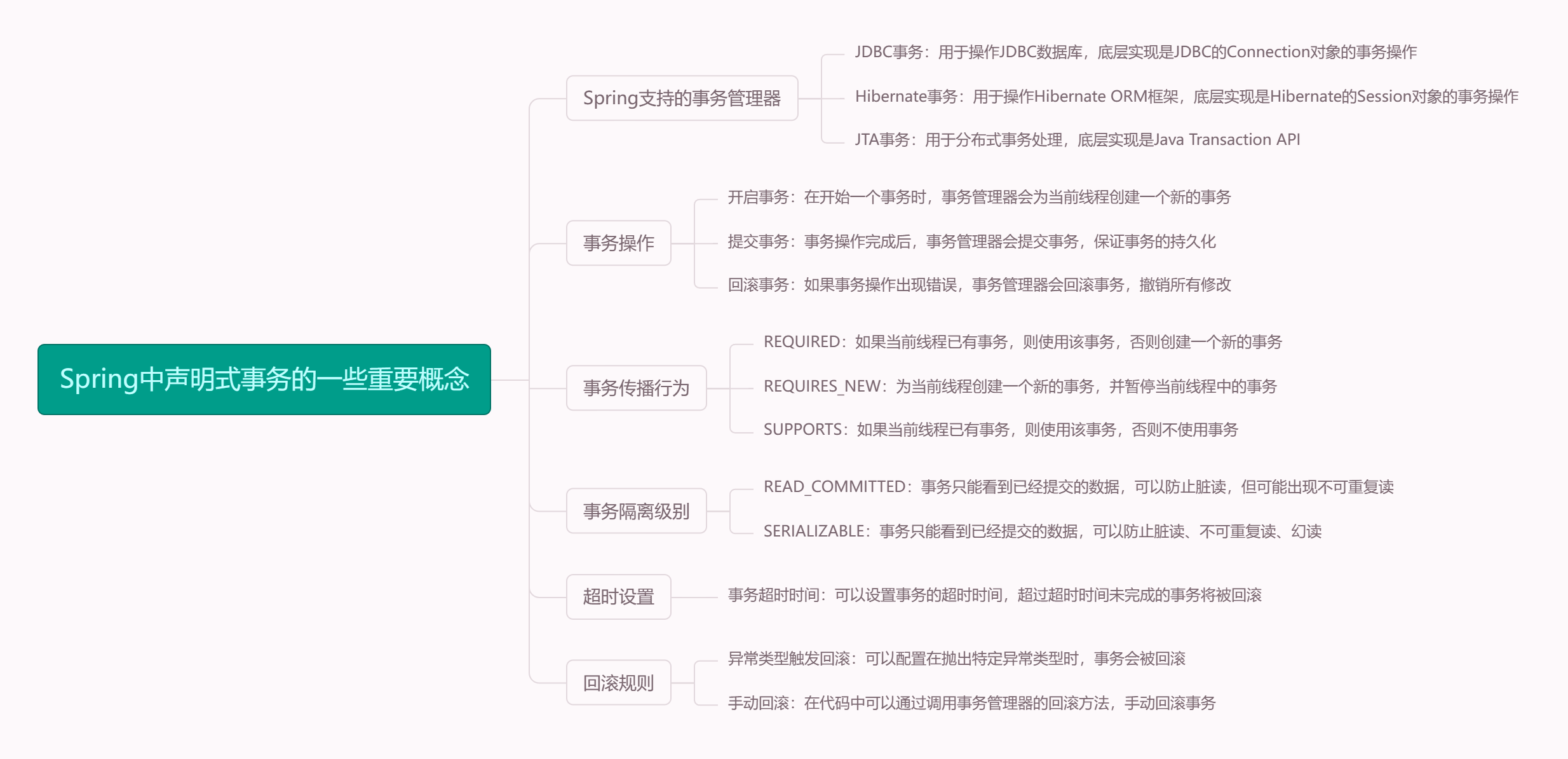
用法:
① 注解
@Transactional(propagation = Propagation.REQUIRED, isolation = Isolation.READ_COMMITTED, timeout = 30, rollbackFor = Exception.class)
public void someTransactionalMethod() {
// 业务逻辑代码
}
②XML配置方式
<tx:advice id="txAdvice" transaction-manager="transactionManager">
<tx:attributes>
<tx:method name="someTransactionalMethod" propagation="REQUIRED" isolation="READ_COMMITTED" timeout="30" rollback-for="Exception"/>
</tx:attributes>
</tx:advice>
<aop:config>
<aop:pointcut id="transactionalMethods" expression="execution(* com.example.service.*.*(..))"/>
<aop:advisor advice-ref="txAdvice" pointcut-ref="transactionalMethods"/>
</aop:config>
所以,我们可以总结下面两个概念:
- 编程式:自己写代码实现功能
- 声明式:通过配置让框架实现功能
3、基于注解的声明式事务
3.1 准备工作
①添加配置
在beans.xml添加配置
<!--扫描组件-->
<context:component-scan base-package="com.jie.jdbc"/>
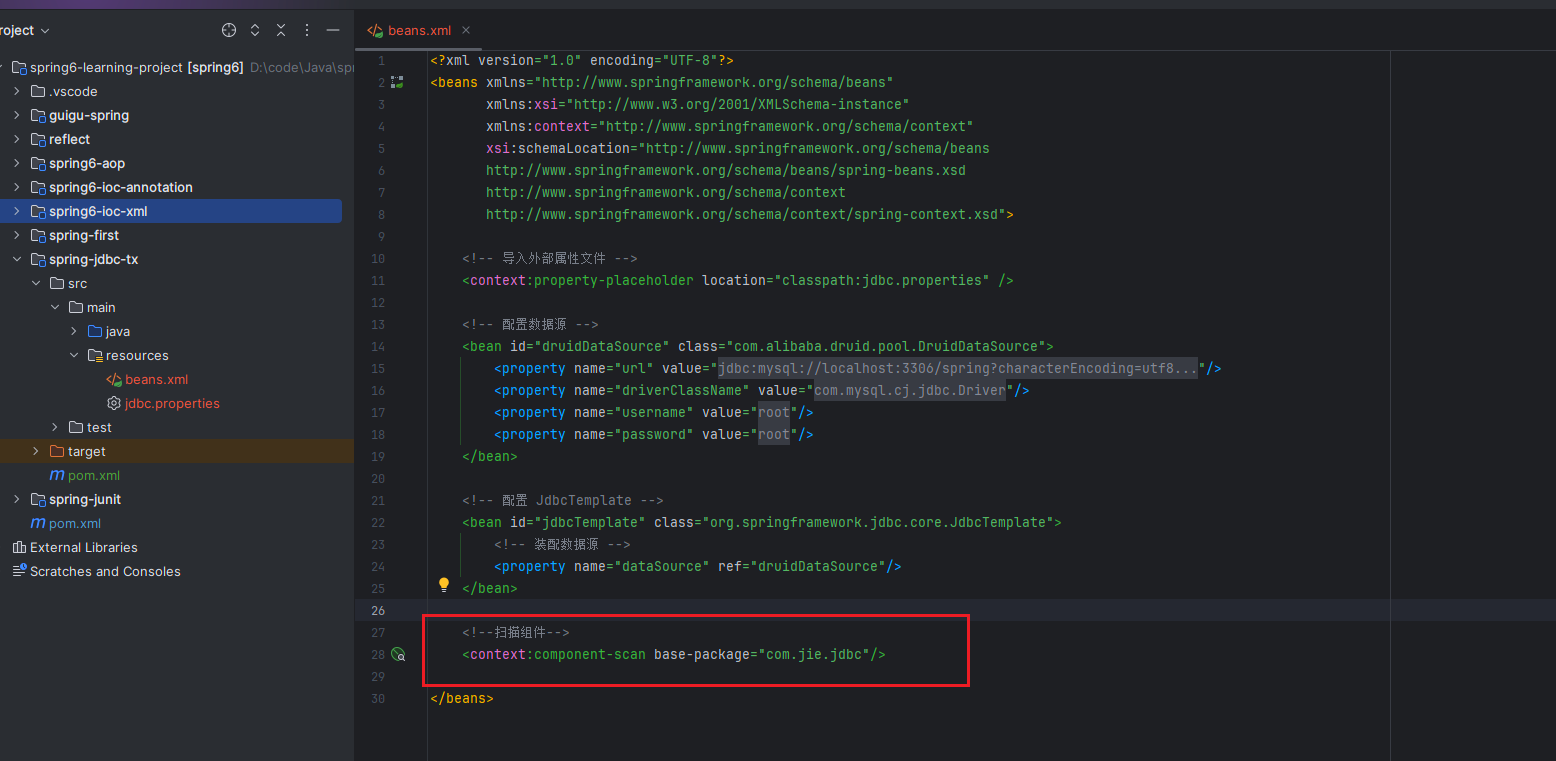
②创建表
CREATE TABLE `t_book` (
`book_id` int(11) NOT NULL AUTO_INCREMENT COMMENT '主键',
`book_name` varchar(20) DEFAULT NULL COMMENT '图书名称',
`price` int(11) DEFAULT NULL COMMENT '价格',
`stock` int(10) unsigned DEFAULT NULL COMMENT '库存(无符号)',
PRIMARY KEY (`book_id`)
) ENGINE=InnoDB AUTO_INCREMENT=3 DEFAULT CHARSET=utf8;
insert into `t_book`(`book_id`,`book_name`,`price`,`stock`) values (1,'斗破苍穹',80,100),(2,'斗罗大陆',50,100);
CREATE TABLE `t_user` (
`user_id` int(11) NOT NULL AUTO_INCREMENT COMMENT '主键',
`username` varchar(20) DEFAULT NULL COMMENT '用户名',
`balance` int(10) unsigned DEFAULT NULL COMMENT '余额(无符号)',
PRIMARY KEY (`user_id`)
) ENGINE=InnoDB AUTO_INCREMENT=2 DEFAULT CHARSET=utf8;
insert into `t_user`(`user_id`,`username`,`balance`) values (1,'admin',50);
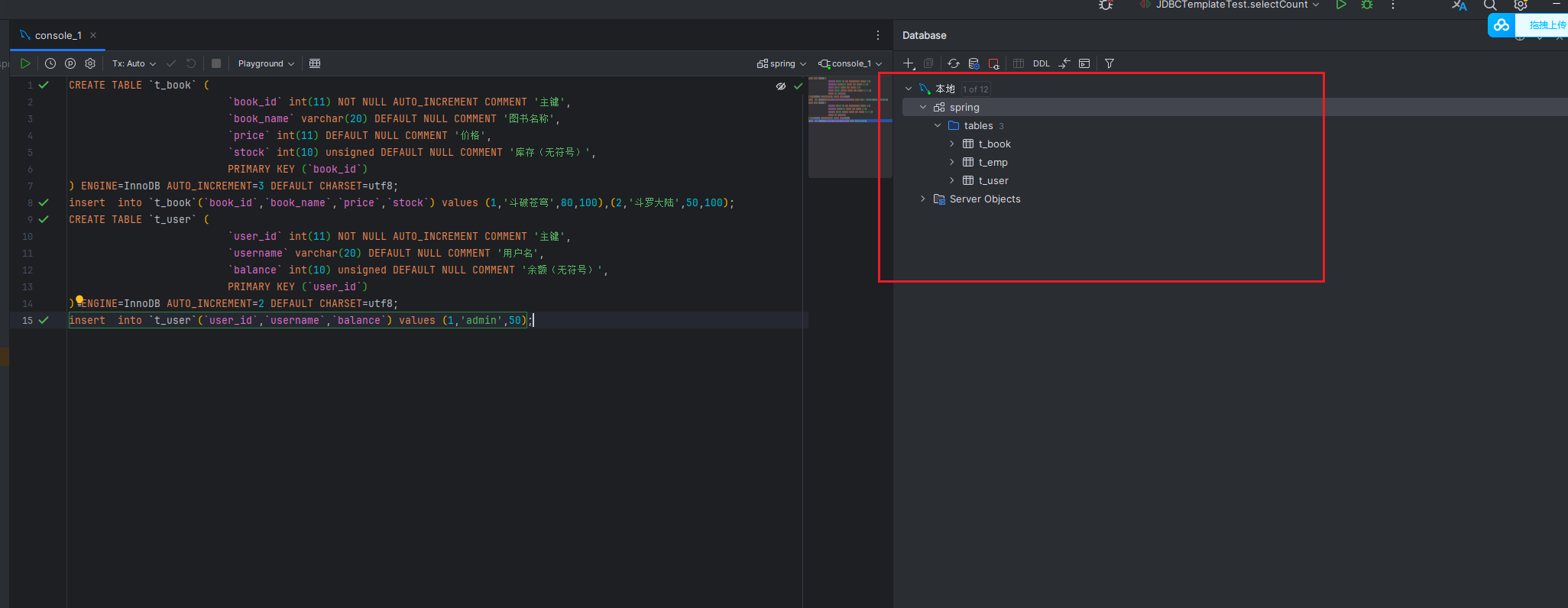
③创建组件
创建BookController:
package com.jie.jdbc.controller;
import com.jie.jdbc.service.BookService;
import org.springframework.beans.factory.annotation.Autowired;
import org.springframework.stereotype.Controller;
@Controller
public class BookController {
@Autowired
private BookService bookService;
public void buyBook(Integer bookId, Integer userId){
bookService.buyBook(bookId, userId);
}
}
创建接口BookService:
package com.jie.jdbc.service;
public interface BookService {
/**
* 购买书籍
*
* @param bookId 书号
* @param userId 用户id
*/
void buyBook(Integer bookId, Integer userId);
}
创建实现类BookServiceImpl:
package com.jie.jdbc.service.impl;
import com.jie.jdbc.mapper.BookMapper;
import com.jie.jdbc.service.BookService;
import org.springframework.beans.factory.annotation.Autowired;
import org.springframework.stereotype.Service;
@Service
public class BookServiceImpl implements BookService {
@Autowired
private BookMapper bookMapper;
@Override
public void buyBook(Integer bookId, Integer userId) {
//查询图书的价格
Integer price = bookMapper.getPriceByBookId(bookId);
//更新图书的库存
bookMapper.updateStock(bookId);
//更新用户的余额
bookMapper.updateBalance(userId, price);
}
}
创建接口BookMapper:
package com.jie.jdbc.mapper;
public interface BookMapper {
/**
* 根据书号获取书的价格
*
* @param bookId 书号
* @return 书的价格
*/
Integer getPriceByBookId(Integer bookId);
/**
* 更新书的库存,每次库存减1
*
* @param bookId 书号
*/
void updateStock(Integer bookId);
/**
* 更新用户的余额,每次减去书的价格
*
* @param userId 用户id
* @param price 书的价格
*/
void updateBalance(Integer userId, Integer price);
}
创建实现类BookMapperImpl:
package com.jie.jdbc.service.impl;
import com.jie.jdbc.mapper.BookMapper;
import org.springframework.beans.factory.annotation.Autowired;
import org.springframework.jdbc.core.JdbcTemplate;
import org.springframework.stereotype.Repository;
@Repository
public class BookMapperImpl implements BookMapper {
@Autowired
private JdbcTemplate jdbcTemplate;
@Override
public Integer getPriceByBookId(Integer bookId) {
String sql = "select price from spring.t_book where book_id = ?";
return jdbcTemplate.queryForObject(sql, Integer.class, bookId);
}
@Override
public void updateStock(Integer bookId) {
String sql = "update spring.t_book set stock = stock - 1 where book_id = ?";
jdbcTemplate.update(sql, bookId);
}
@Override
public void updateBalance(Integer userId, Integer price) {
String sql = "update spring.t_user set balance = balance - ? where user_id = ?";
jdbcTemplate.update(sql, price, userId);
}
}
3.2 测试无事务情况
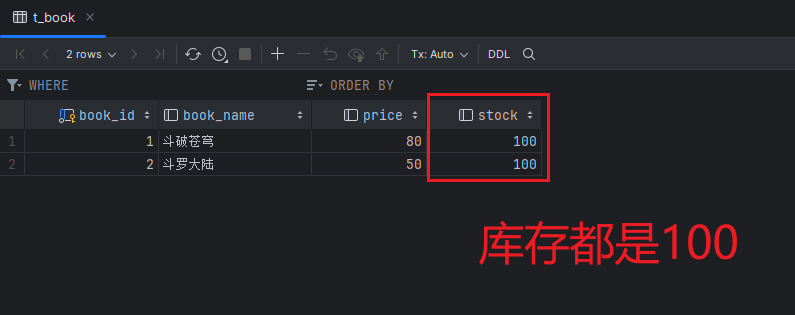

让我们执行一下买书的代码。
import com.jie.jdbc.controller.BookController;
import org.junit.jupiter.api.Test;
import org.springframework.beans.factory.annotation.Autowired;
import org.springframework.test.context.junit.jupiter.SpringJUnitConfig;
@SpringJUnitConfig(locations = "classpath:beans.xml")
public class TxByAnnotationTest {
@Autowired
private BookController bookController;
@Test
public void testBuyBook() {
// 1. 调用controller的buyBook方法
bookController.buyBook(1, 1);
}
}
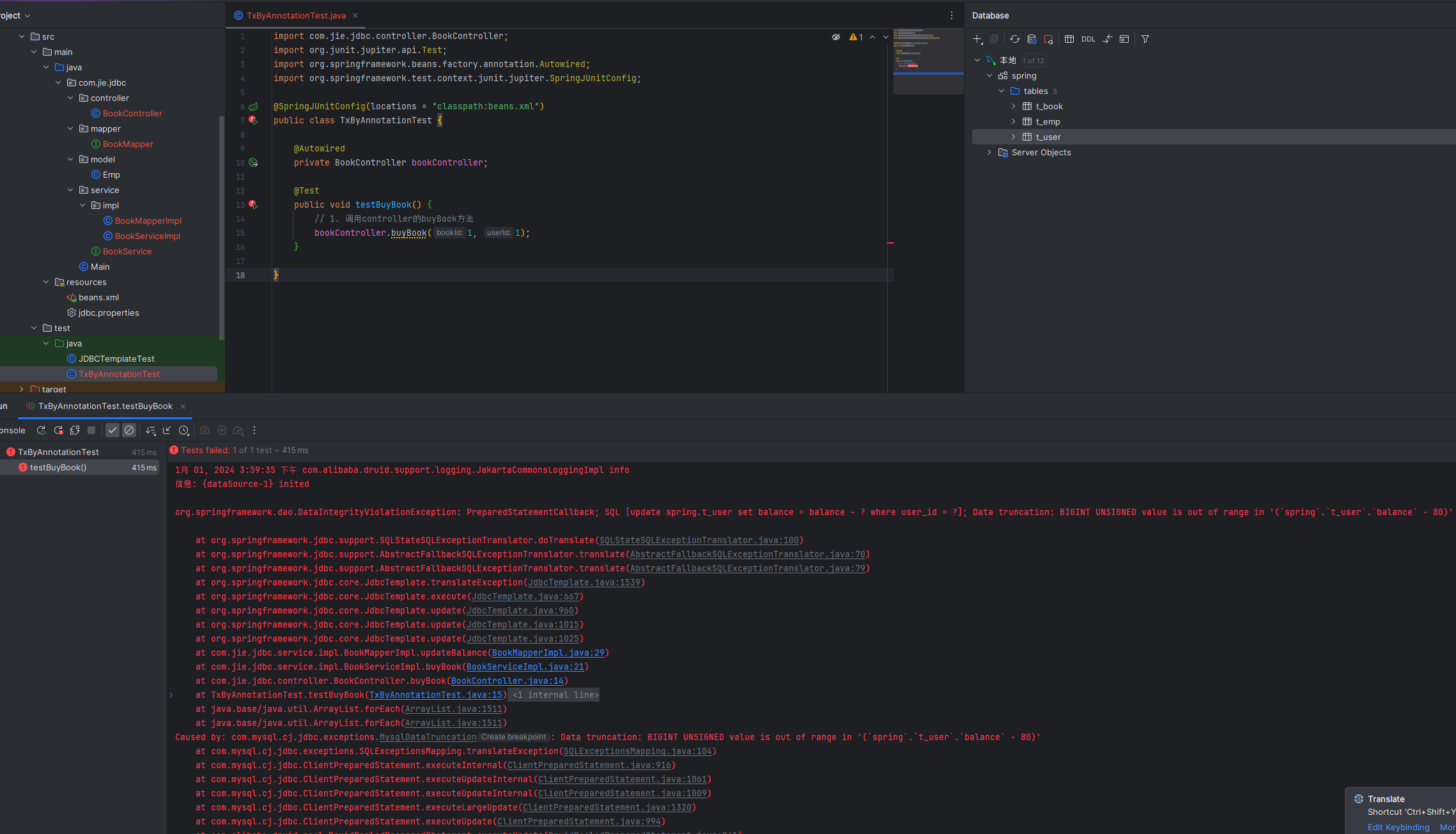
用户余额为50,而图书价格为80
购买图书之后,用户的余额为-30,数据库中余额字段设置了无符号,因此无法将-30插入到余额字段
此时执行sql语句会抛出SQLException。
让我们来看看数据库的数据变化。
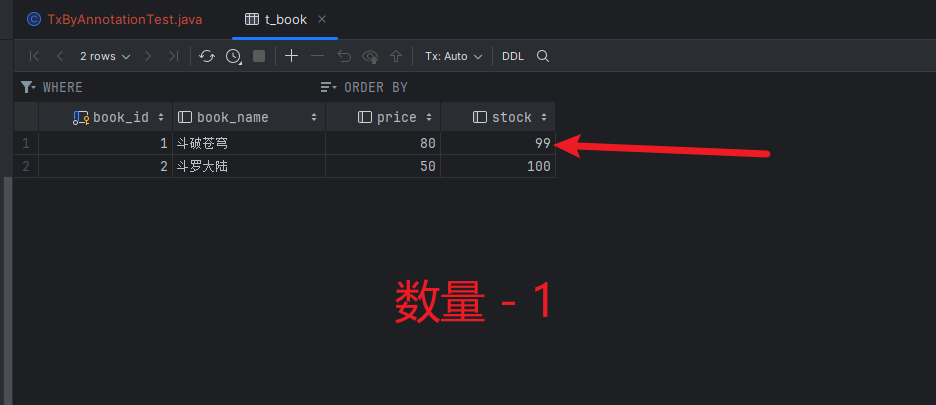

因为没有添加事务,图书的库存更新了,但是用户的余额没有更新
显然这样的结果是错误的,购买图书是一个完整的功能,更新库存和更新余额要么都成功要么都失败
3.3、加入事务
①添加事务配置
在spring配置文件中引入tx命名空间并在Spring的配置文件中添加配置:
<?xml version="1.0" encoding="UTF-8"?>
<beans xmlns="http://www.springframework.org/schema/beans"
xmlns:xsi="http://www.w3.org/2001/XMLSchema-instance"
xmlns:context="http://www.springframework.org/schema/context"
xmlns:tx="http://www.springframework.org/schema/tx"
xsi:schemaLocation="http://www.springframework.org/schema/beans
http://www.springframework.org/schema/beans/spring-beans.xsd
http://www.springframework.org/schema/context
http://www.springframework.org/schema/context/spring-context.xsd
http://www.springframework.org/schema/tx
http://www.springframework.org/schema/tx/spring-tx.xsd">
<!-- 导入外部属性文件 -->
<context:property-placeholder location="classpath:jdbc.properties" />
<!-- 配置数据源 -->
<bean id="druidDataSource" class="com.alibaba.druid.pool.DruidDataSource">
<property name="url" value="${jdbc.url}"/>
<property name="driverClassName" value="${jdbc.driver}"/>
<property name="username" value="${jdbc.user}"/>
<property name="password" value="${jdbc.password}"/>
</bean>
<!-- 配置 JdbcTemplate -->
<bean id="jdbcTemplate" class="org.springframework.jdbc.core.JdbcTemplate">
<!-- 装配数据源 -->
<property name="dataSource" ref="druidDataSource"/>
</bean>
<!--扫描组件-->
<context:component-scan base-package="com.jie.jdbc"/>
<bean id="transactionManager" class="org.springframework.jdbc.datasource.DataSourceTransactionManager">
<property name="dataSource" ref="druidDataSource"/>
</bean>
<!--
开启事务的注解驱动
通过注解@Transactional所标识的方法或标识的类中所有的方法,都会被事务管理器管理事务
-->
<!-- transaction-manager属性的默认值是transactionManager,如果事务管理器bean的id正好就是这个默认值,则可以省略这个属性 -->
<tx:annotation-driven transaction-manager="transactionManager" />
</beans>
②添加事务注解
因为service层表示业务逻辑层,一个方法表示一个完成的功能,因此处理事务一般在service层处理
在BookServiceImpl的buybook()添加注解@Transactional
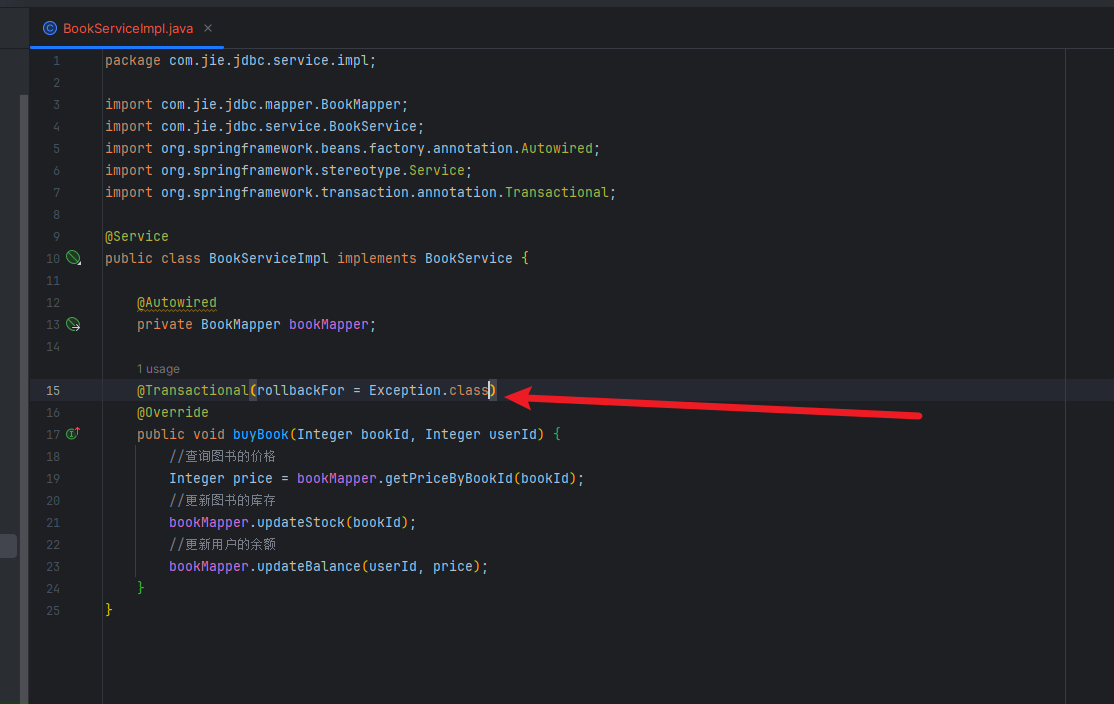
③观察结果
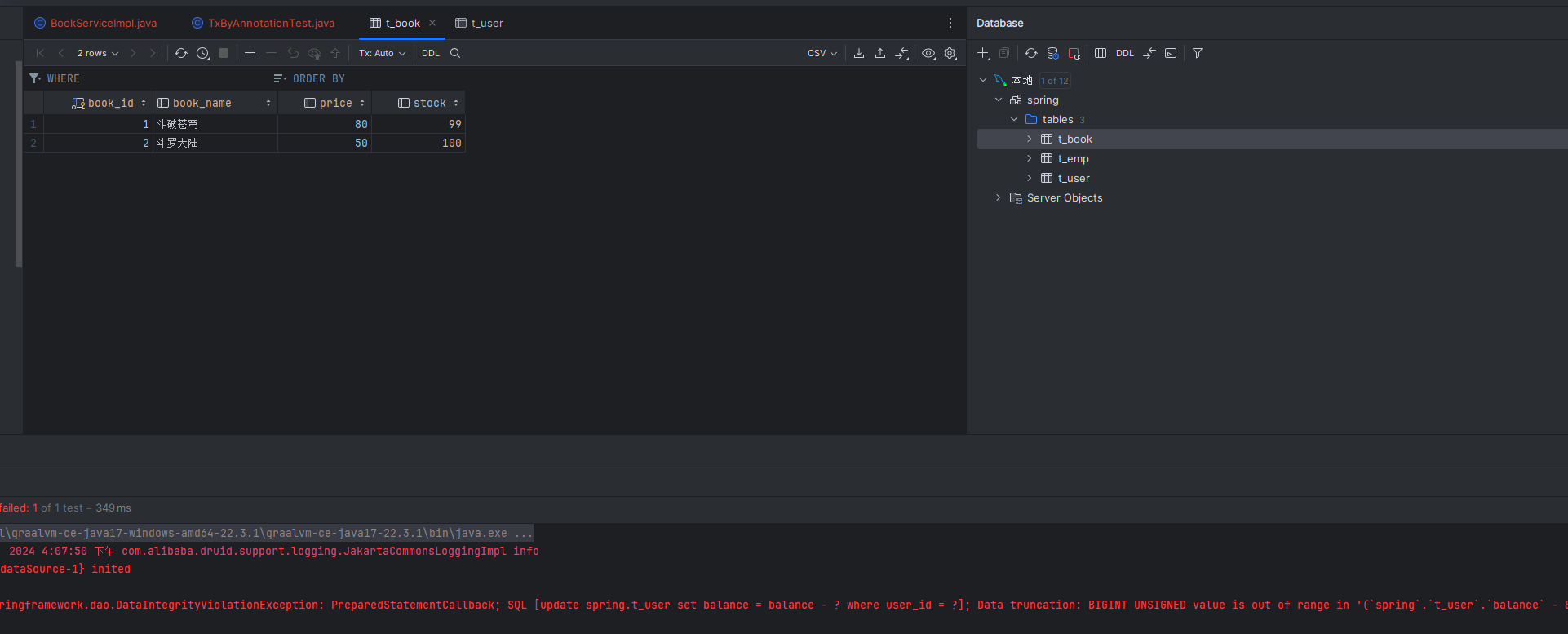
这次添加了事务注解,更新库存和更新余额都没有执行。
3.4 @Transactional注解标识的位置
@Transactional标识在方法上,则只会影响该方法
@Transactional标识的类上,则会影响类中所有的方法
3.5 事务属性:只读
①介绍
只读,是什么意思呢?它表示如果说咱们设置成只读属性,就表示你只能做这个查询操作,而不能做修改、添加、删除这些操作。
②使用方式
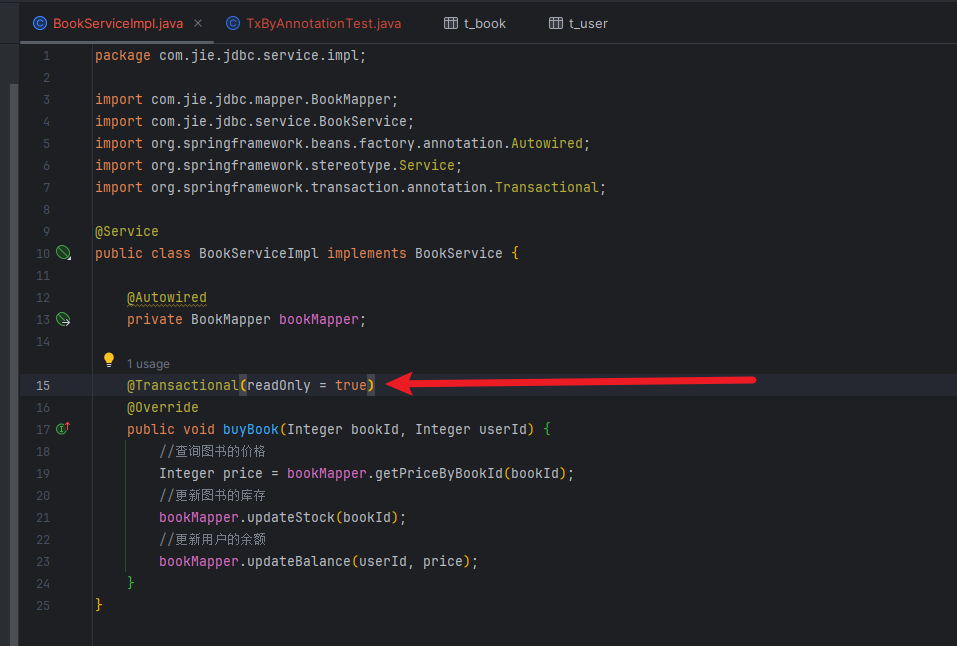
我们再来执行一下测试代码看看效果。
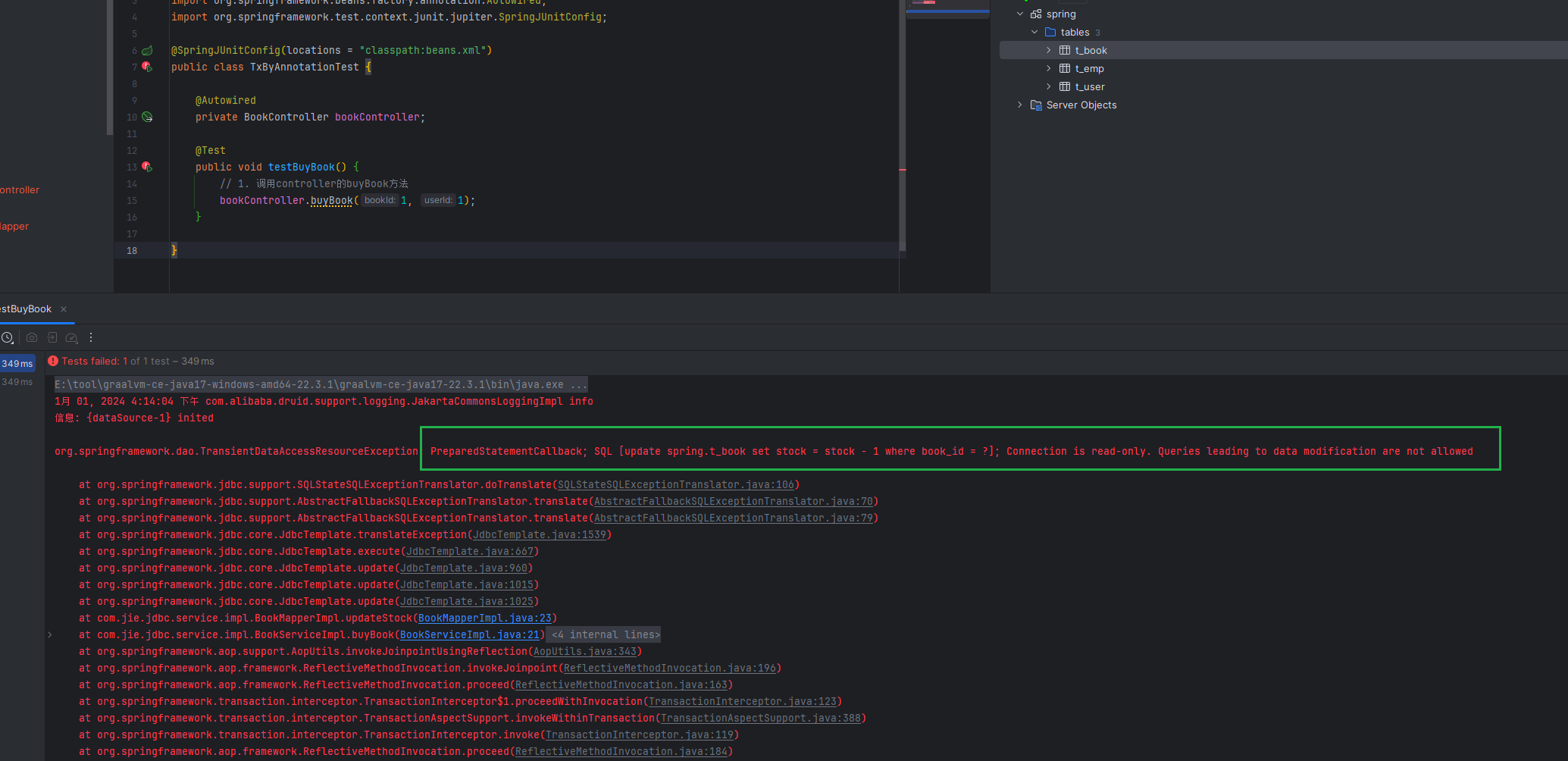
我们看他报的什么错,这里写到说你当前的操作不被允许。为什么?
因为目前你是一个read only,就是你只能做查操作。但是我刚才操作中,大家也看到里边是不是有修改操作,所以它就不被允许进行。这就是第一个属性,叫readOnly只读。只能做查询,涉及到写操作,比如添加、修改、删除,它就直接报这个错误。
3.6 事务属性:超时
①介绍
事务在执行过程中,有可能因为遇到某些问题,导致程序卡住,从而长时间占用数据库资源。而长时间占用资源,大概率是因为程序运行出现了问题(可能是Java程序或MySQL数据库或网络连接等等)。此时这个很可能出问题的程序应该被回滚,撤销它已做的操作,事务结束,把资源让出来,让其他正常程序可以执行。
概括来说就是一句话:超时回滚,释放资源。
②使用方式
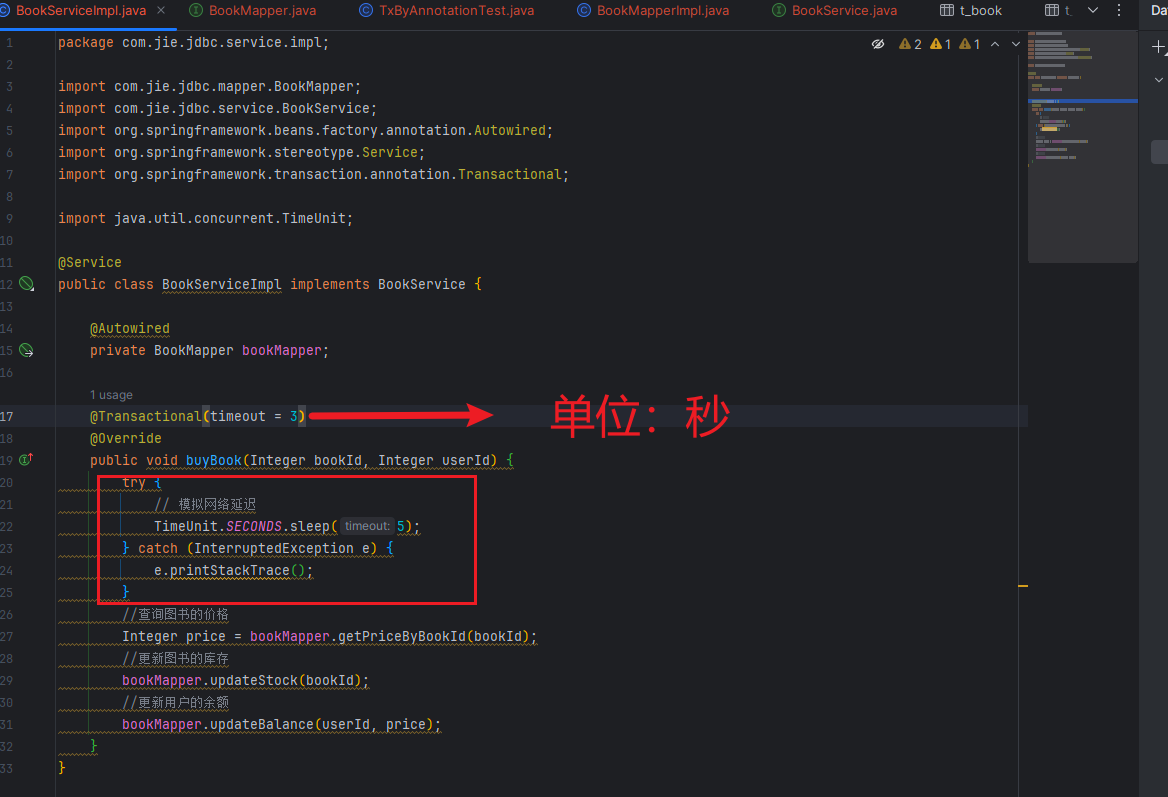
③观察结果
我们再次执行测试代码。
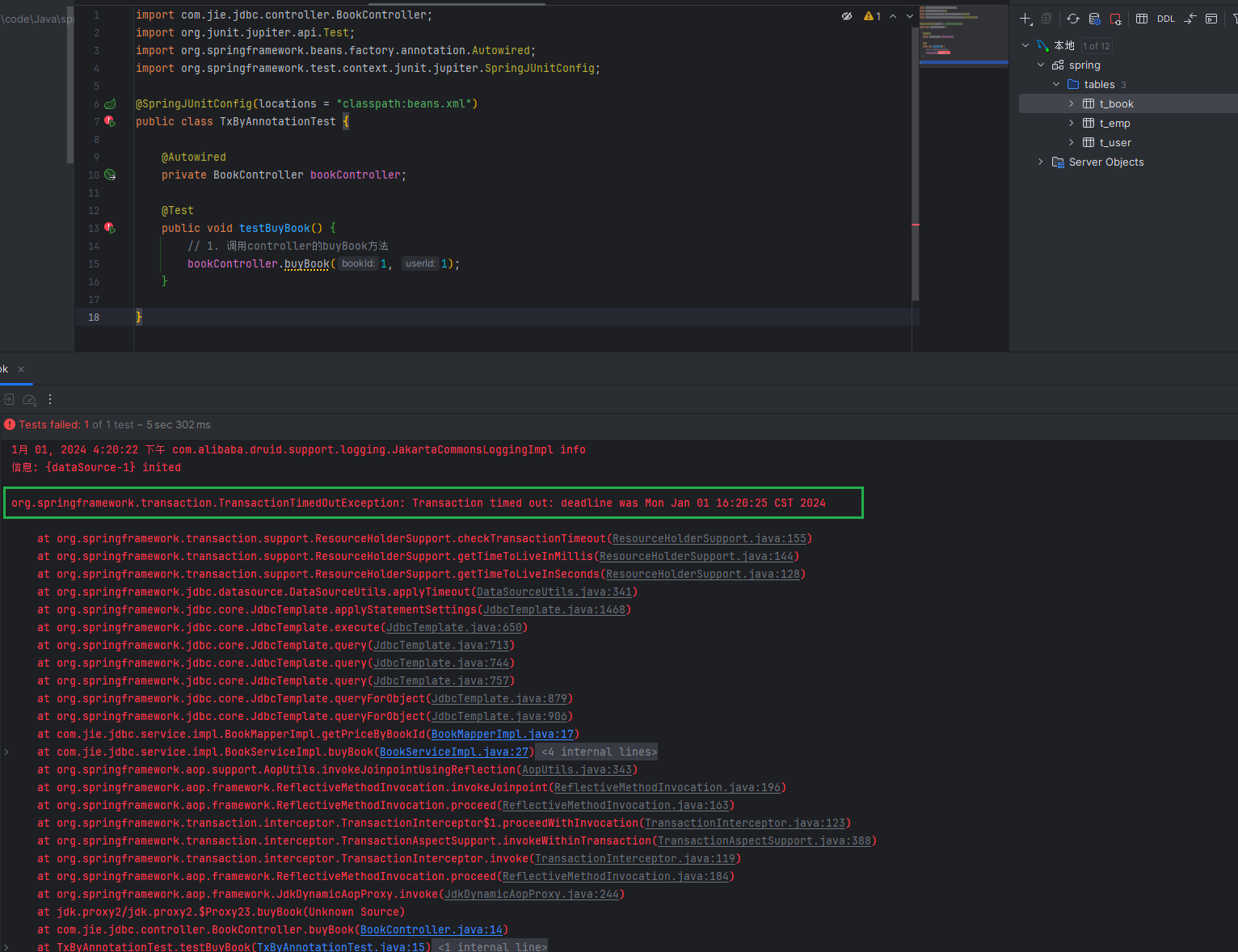
3.7 事务属性:回滚策略
①介绍
声明式事务默认只针对运行时异常回滚,编译时异常不回滚。
可以通过@Transactional中相关属性设置回滚策略
rollbackFor属性:需要设置一个Class类型的对象
rollbackForClassName属性:需要设置一个字符串类型的全类名
noRollbackFor属性:需要设置一个Class类型的对象
rollbackFor属性:需要设置一个字符串类型的全类名
②使用方式
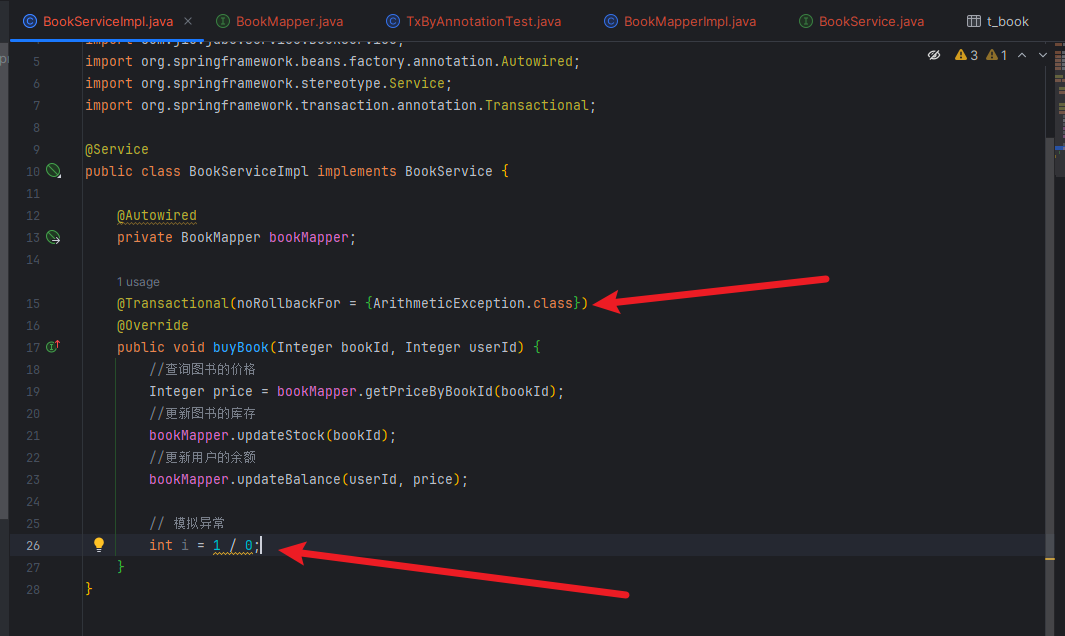
③观察结果
改一下书籍价格和库存。

执行测试代码。
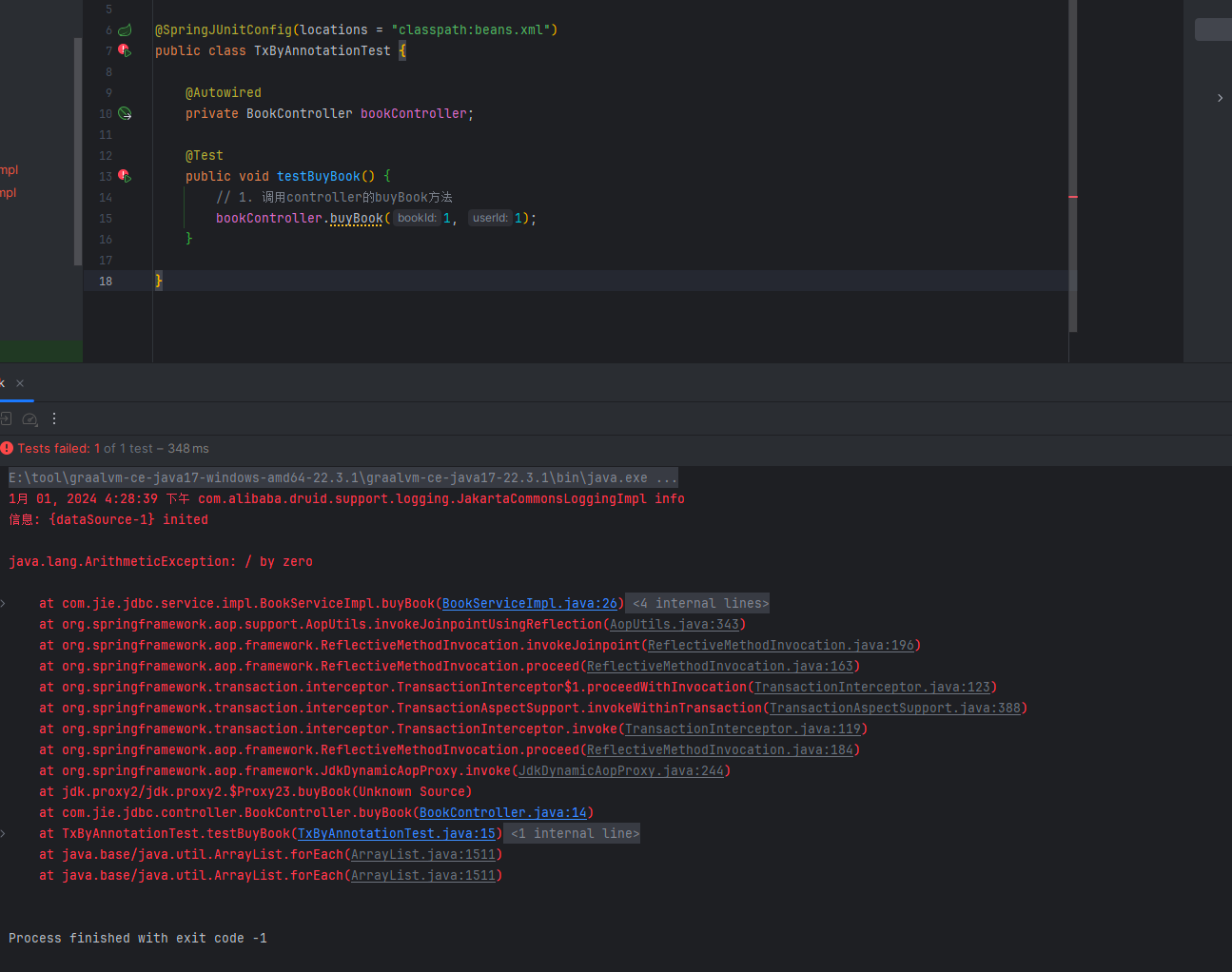
可以看到已经报错了,让我们看看数据库的数据。
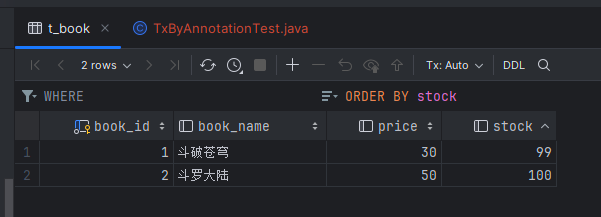

虽然购买图书功能中出现了数学运算异常(ArithmeticException),但是我们设置的回滚策略是,当出现ArithmeticException不发生回滚,因此购买图书的操作正常执行
3.8 事务属性:隔离级别
①介绍
数据库系统必须具有隔离并发运行各个事务的能力,使它们不会相互影响,避免各种并发问题。一个事务与其他事务隔离的程度称为隔离级别。
SQL标准中规定了多种事务隔离级别,不同隔离级别对应不同的干扰程度,隔离级别越高,数据一致性就越好,但并发性越弱。
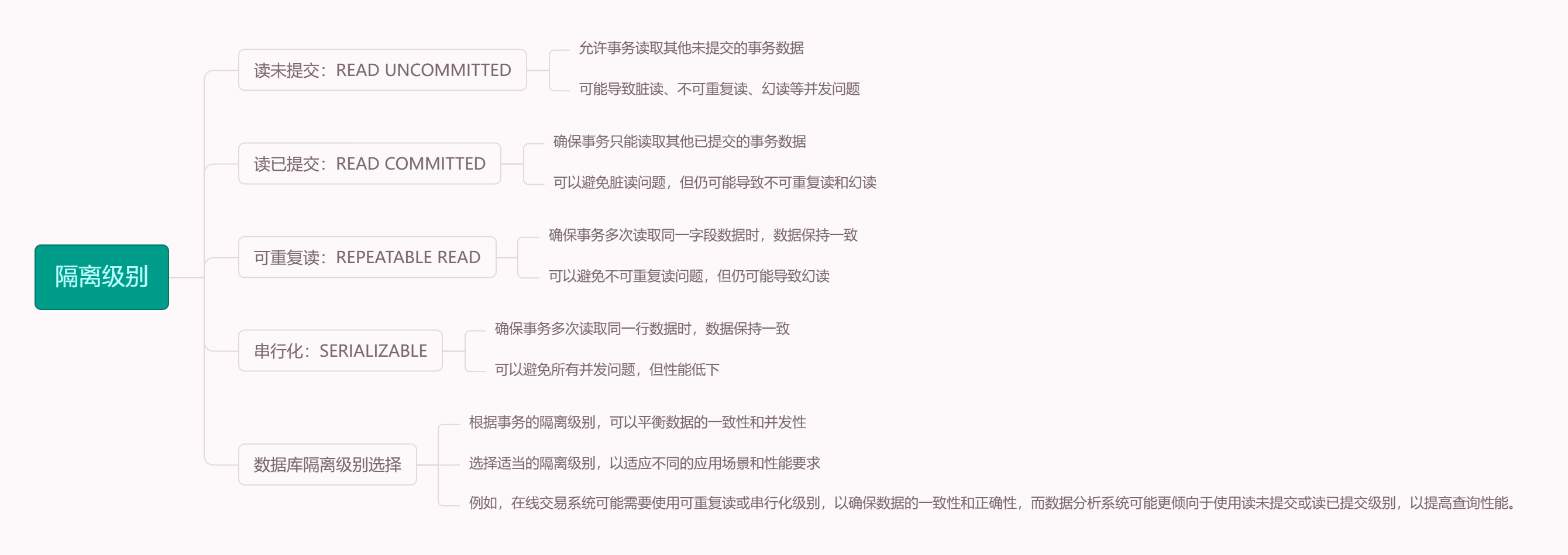
各个隔离级别解决并发问题的能力见下表:
| 隔离级别 | 脏读 | 不可重复读 | 幻读 |
|---|---|---|---|
| READ UNCOMMITTED | 有 | 有 | 有 |
| READ COMMITTED | 无 | 有 | 有 |
| REPEATABLE READ | 无 | 无 | 有 |
| SERIALIZABLE | 无 | 无 | 无 |

各种数据库产品对事务隔离级别的支持程度:
| 隔离级别 | Oracle | MySQL |
|---|---|---|
| READ UNCOMMITTED | × | √ |
| READ COMMITTED | √(默认) | √ |
| REPEATABLE READ | × | √(默认) |
| SERIALIZABLE | √ | √ |
②使用方式
@Transactional(isolation = Isolation.DEFAULT)//使用数据库默认的隔离级别
@Transactional(isolation = Isolation.READ_UNCOMMITTED)//读未提交
@Transactional(isolation = Isolation.READ_COMMITTED)//读已提交
@Transactional(isolation = Isolation.REPEATABLE_READ)//可重复读
@Transactional(isolation = Isolation.SERIALIZABLE)//串行化
3.9 事务属性:传播行为
①介绍
什么是事务的传播行为?
在service类中有a()方法和b()方法,a()方法上有事务,b()方法上也有事务,当a()方法执行过程中调用了b()方法,事务是如何传递的?合并到一个事务里?还是开启一个新的事务?这就是事务传播行为。
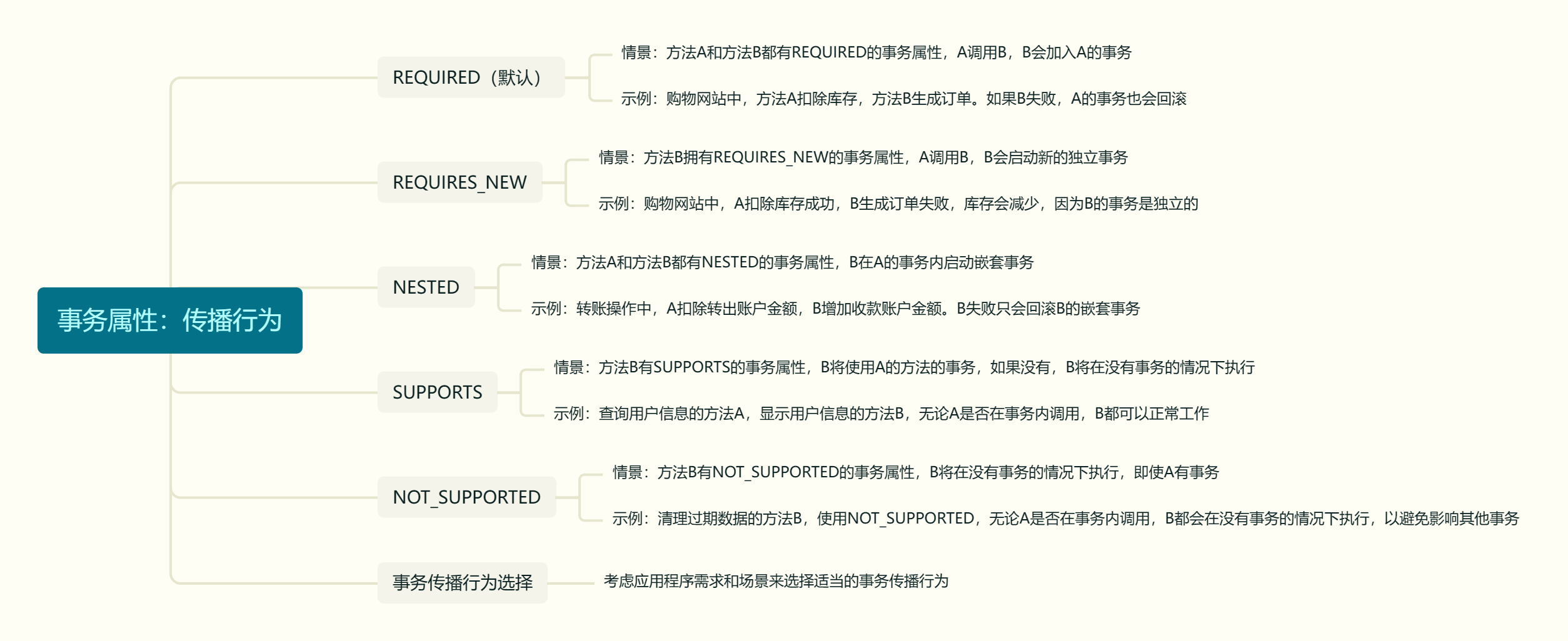
②测试
创建接口CheckoutService:
package com.jie.jdbc.service;
public interface CheckoutService {
/**
* 结账
*
* @param bookIds 购买的书籍id
* @param userId 用户id
* @return: void
* @date: 2023/10/30 4:16
*/
void checkout(Integer[] bookIds, Integer userId);
}
创建实现类CheckoutServiceImpl:
package com.jie.jdbc.service.impl;
import com.jie.jdbc.service.BookService;
import com.jie.jdbc.service.CheckoutService;
import org.springframework.beans.factory.annotation.Autowired;
import org.springframework.stereotype.Service;
import org.springframework.transaction.annotation.Transactional;
@Service
public class CheckoutServiceImpl implements CheckoutService {
@Autowired
private BookService bookService;
@Override
@Transactional(rollbackFor = Exception.class)
public void checkout(Integer[] bookIds, Integer userId) {
// 循环购买书籍
for (Integer bookId : bookIds) {
// 调用购买书籍的方法
bookService.buyBook(bookId, userId);
}
}
}
在BookController中添加方法:
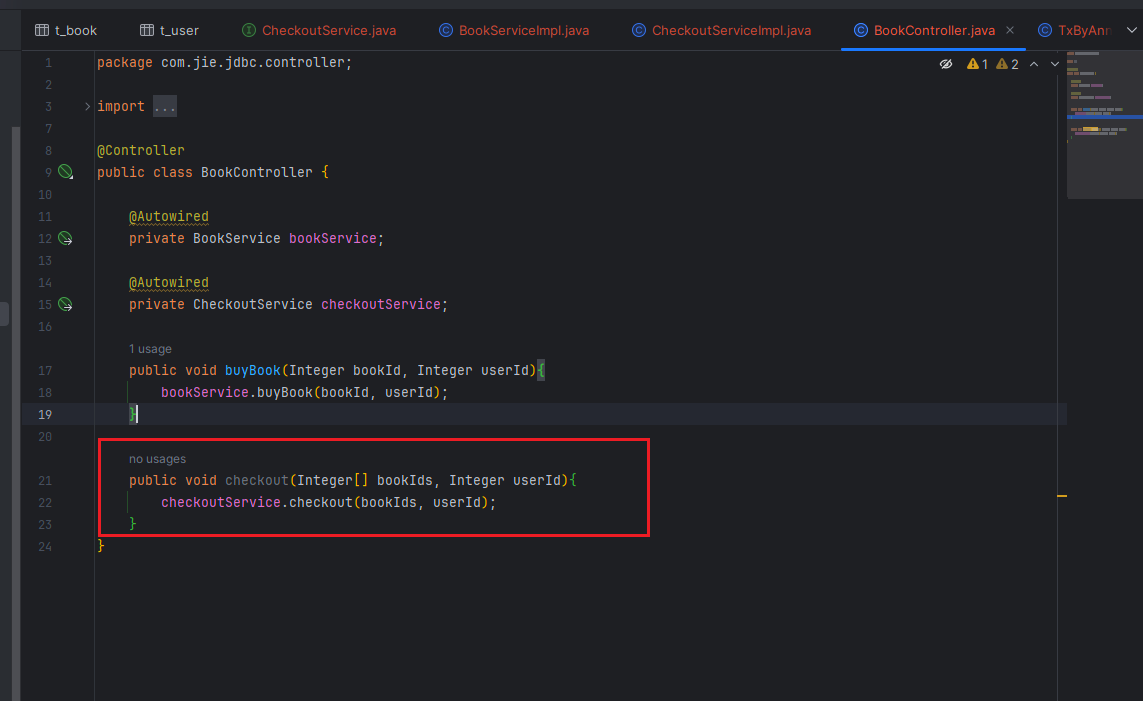
在数据库中将用户的余额修改为100元和修改图书价格


③观察结果
可以通过@Transactional中的propagation属性设置事务传播行为.
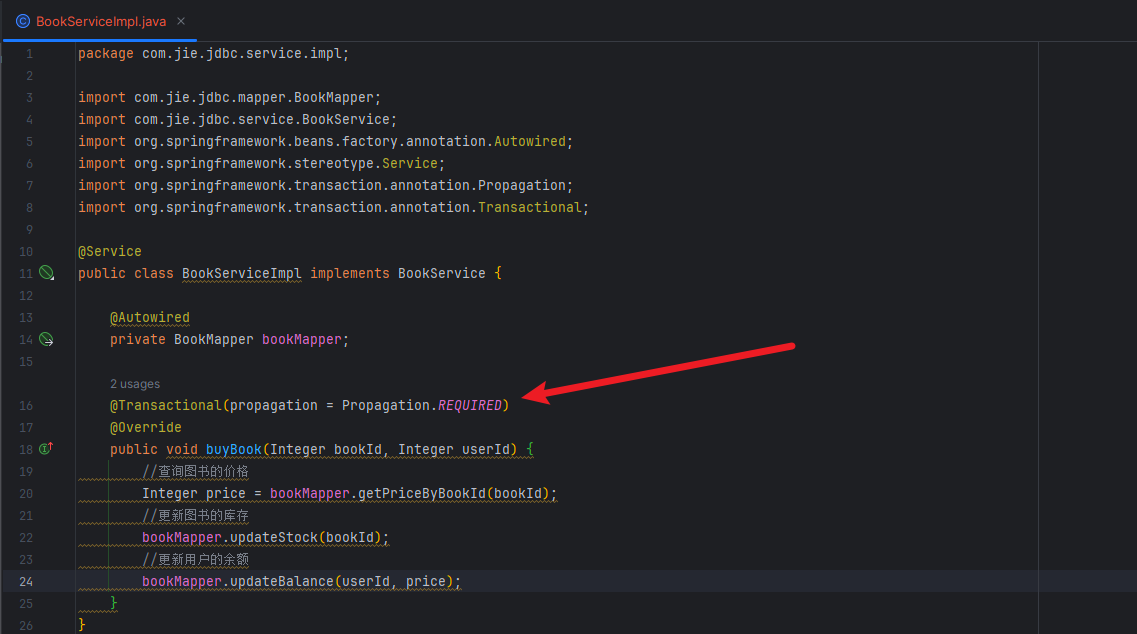
默认情况,表示如果当前线程上有已经开启的事务可用,那么就在这个事务中运行。
让我们测试一下代码。
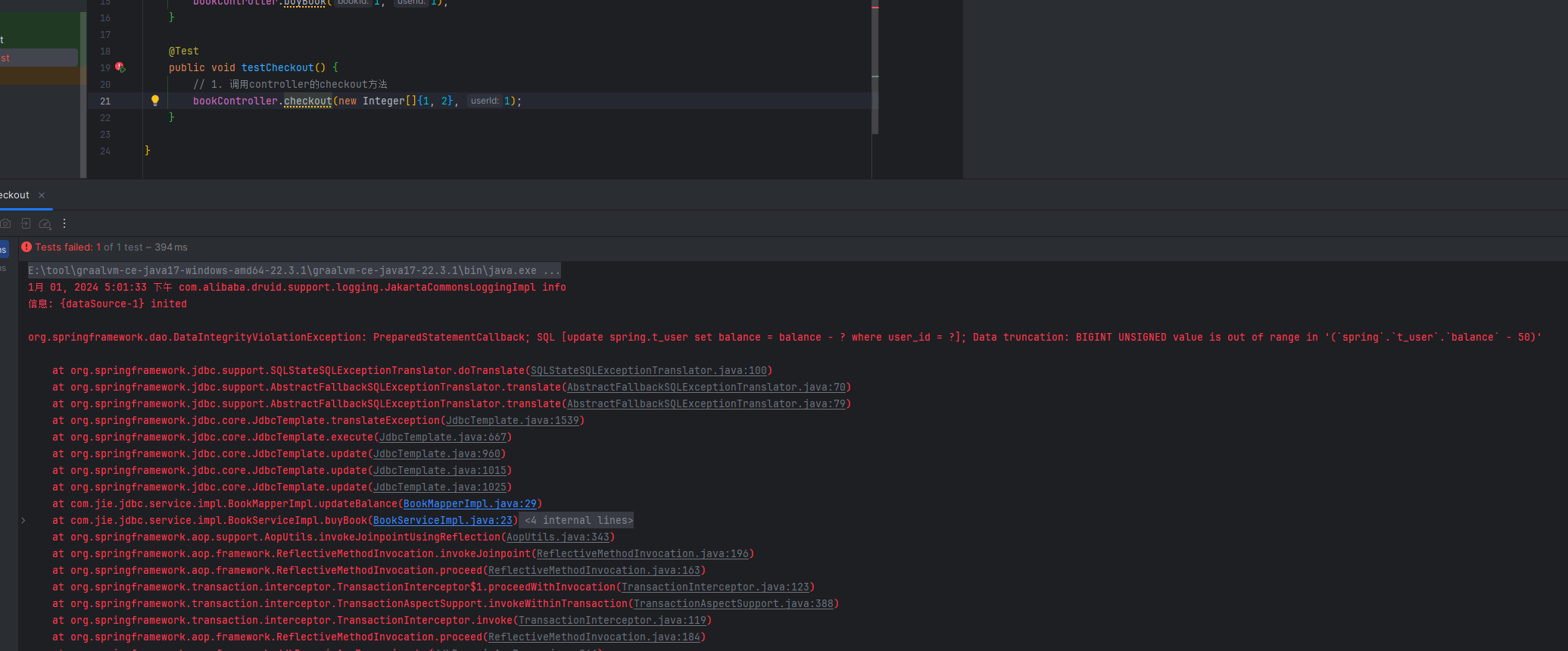
经过观察,购买图书的方法buyBook()在checkout()中被调用,checkout()上有事务注解,因此在此事务中执行。
所购买的两本图书的价格为80和50,而用户的余额为100,因此在购买第二本图书时余额不足失败,导致整个checkout()回滚,即只要有一本书买不了,就都买不了。


我们再修改一下事务的传播行为。
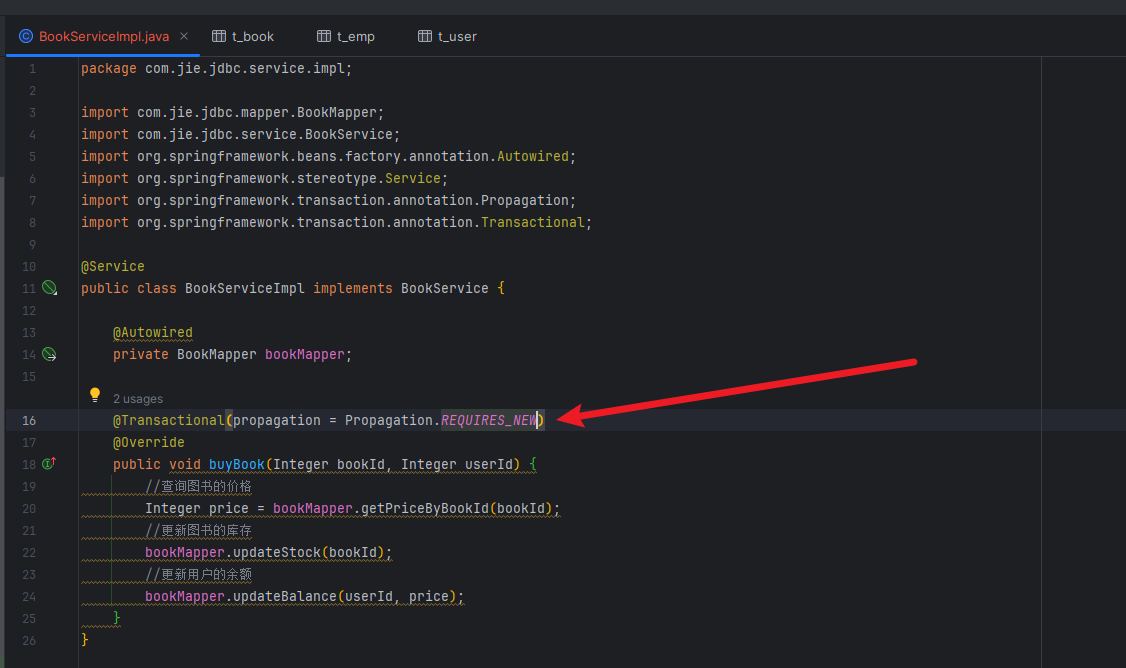
@Transactional(propagation = Propagation.REQUIRES_NEW),表示不管当前线程上是否有已经开启的事务,都要开启新事务。
再次测试代码。
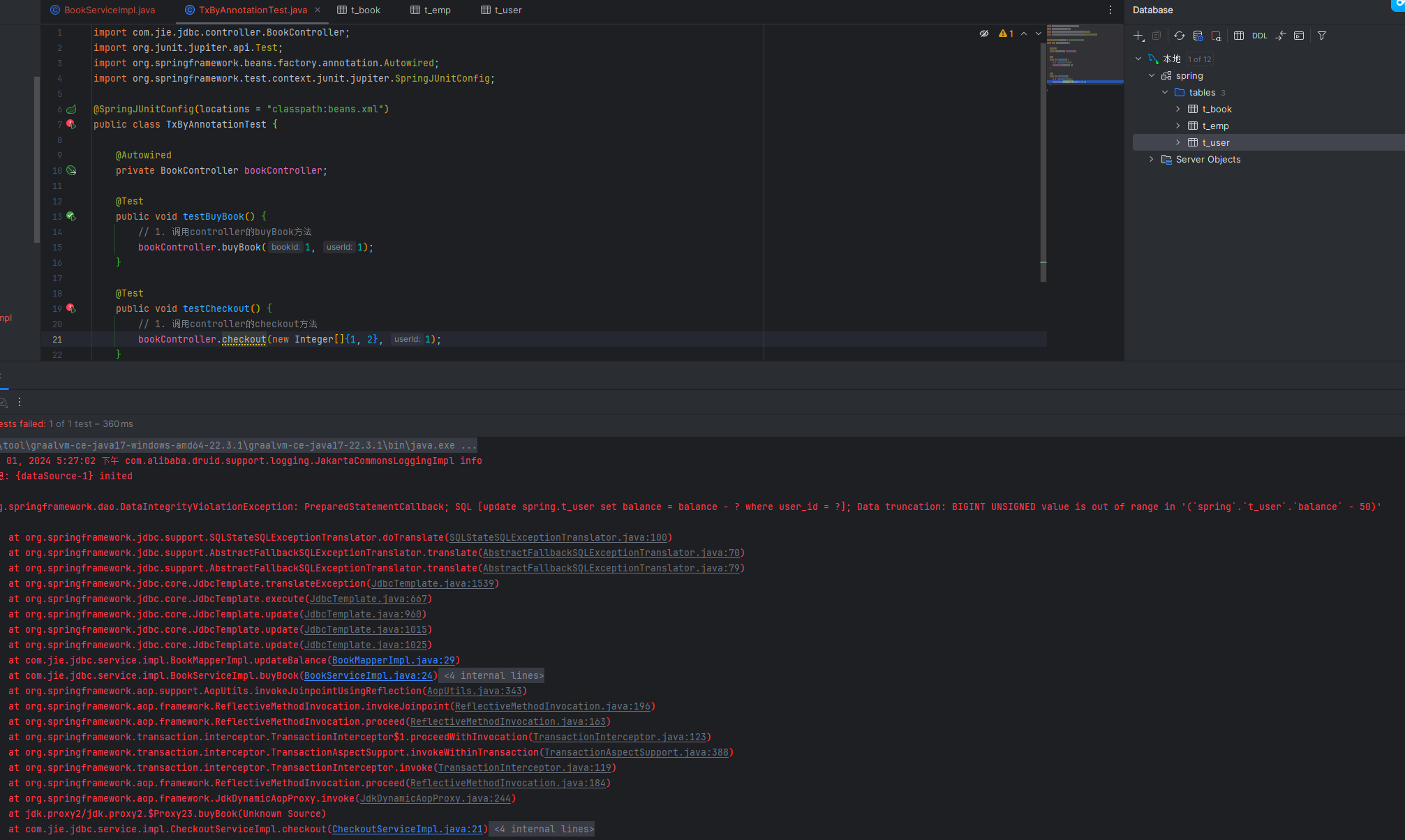


同样的场景,每次购买图书都是在buyBook()的事务中执行,因此第一本图书购买成功,事务结束,第二本图书购买失败,只在第二次的buyBook()中回滚,购买第一本图书不受影响,即能买几本就买几本。
3.10 全注解配置事务
①添加配置类
package com.jie.jdbc.config;
import com.alibaba.druid.pool.DruidDataSource;
import org.springframework.context.annotation.Bean;
import org.springframework.context.annotation.ComponentScan;
import org.springframework.context.annotation.Configuration;
import org.springframework.context.annotation.Primary;
import org.springframework.jdbc.core.JdbcTemplate;
import org.springframework.jdbc.datasource.DataSourceTransactionManager;
import org.springframework.transaction.annotation.EnableTransactionManagement;
import javax.sql.DataSource;
@Configuration
@ComponentScan("com.jie.jdbc")
@EnableTransactionManagement
public class SpringConfig {
/**
* @return DataSource 数据源
* @Primary注解的作用是:当有多个同类型的Bean时,优先使用被@Primary注解的Bean
*/
@Primary
@Bean
public DataSource getDataSource() {
DruidDataSource dataSource = new DruidDataSource();
dataSource.setDriverClassName("com.mysql.cj.jdbc.Driver");
dataSource.setUrl("jdbc:mysql://localhost:3306/spring?characterEncoding=utf8&useSSL=false");
dataSource.setUsername("root");
dataSource.setPassword("root");
return dataSource;
}
@Bean(name = "jdbcTemplate")
public JdbcTemplate getJdbcTemplate(DataSource dataSource) {
JdbcTemplate jdbcTemplate = new JdbcTemplate();
jdbcTemplate.setDataSource(dataSource);
return jdbcTemplate;
}
@Bean
public DataSourceTransactionManager getDataSourceTransactionManager(DataSource dataSource) {
DataSourceTransactionManager dataSourceTransactionManager = new DataSourceTransactionManager();
dataSourceTransactionManager.setDataSource(dataSource);
return dataSourceTransactionManager;
}
}
②测试
@Test
public void testTxAllAnnotation() {
// 1. 调用controller的checkout方法
ApplicationContext applicationContext = new AnnotationConfigApplicationContext(SpringConfig.class);
// 2. 获取controller对象
BookController accountService = applicationContext.getBean("bookController", BookController.class);
// 3. 调用方法
accountService.buyBook(1, 1);
}
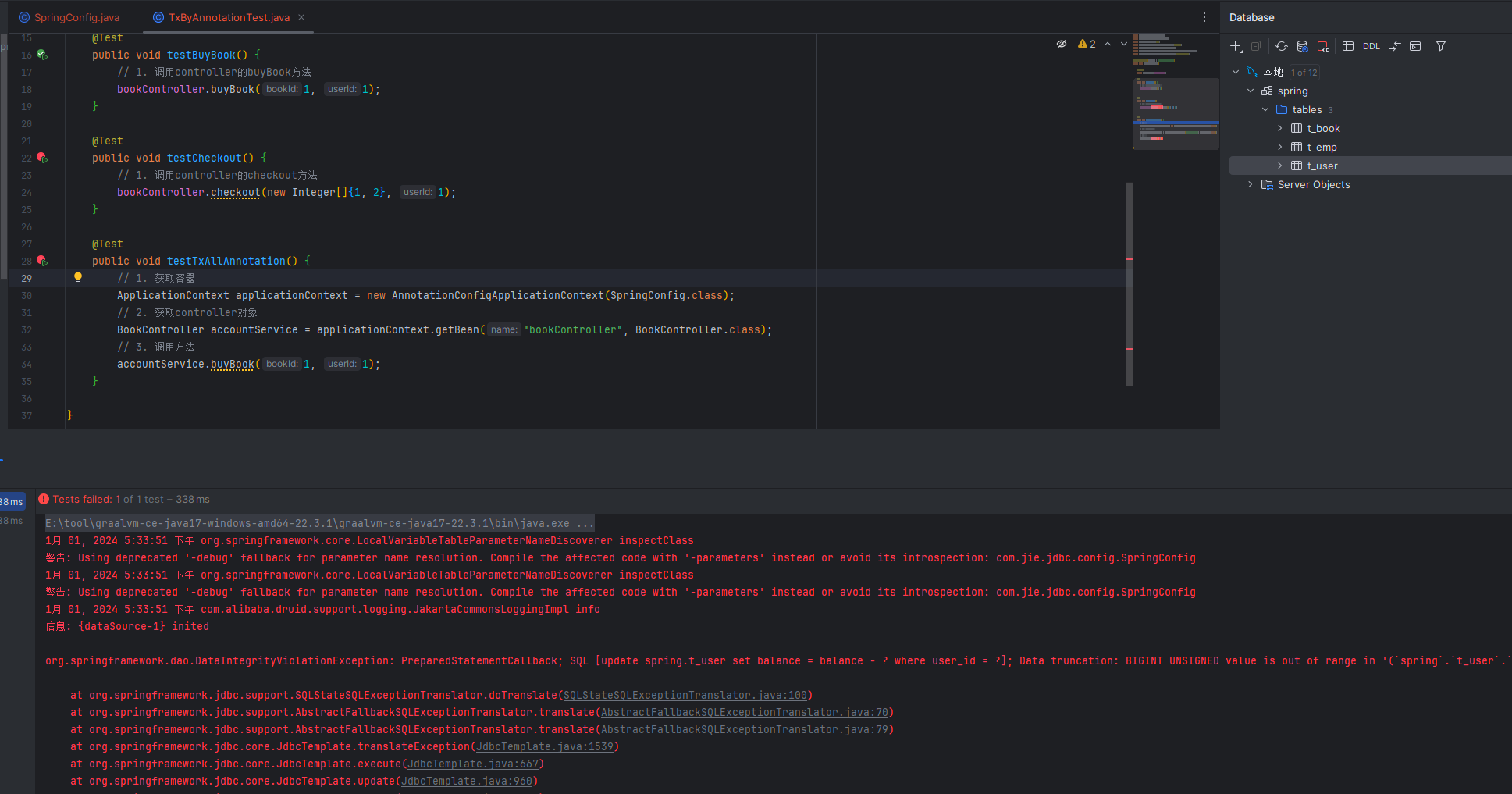
4、基于XML的声明式事务
Spring基于XML的声明式事务管理是通过AOP(Aspect-Oriented Programming,面向切面编程)来实现的。它允许你通过XML配置文件来定义事务的属性,而不需要在业务逻辑中编写事务管理代码。以下是Spring基于XML的声明式事务是如何实现的简要步骤:
4.1、准备工作
可以直接把基于注解的声明式事务的工程直接拷贝一份,改个名字即可
4.2、修改Spring配置文件
将Spring配置文件中去掉tx:annotation-driven 标签,并添加配置:
<aop:config>
<!-- 配置事务通知和切入点表达式 -->
<aop:advisor advice-ref="txAdvice" pointcut="execution(* com.atguigu.spring.tx.xml.service.impl.*.*(..))"></aop:advisor>
</aop:config>
<!-- tx:advice标签:配置事务通知 -->
<!-- id属性:给事务通知标签设置唯一标识,便于引用 -->
<!-- transaction-manager属性:关联事务管理器 -->
<tx:advice id="txAdvice" transaction-manager="transactionManager">
<tx:attributes>
<!-- tx:method标签:配置具体的事务方法 -->
<!-- name属性:指定方法名,可以使用星号代表多个字符 -->
<tx:method name="get*" read-only="true"/>
<tx:method name="query*" read-only="true"/>
<tx:method name="find*" read-only="true"/>
<!-- read-only属性:设置只读属性 -->
<!-- rollback-for属性:设置回滚的异常 -->
<!-- no-rollback-for属性:设置不回滚的异常 -->
<!-- isolation属性:设置事务的隔离级别 -->
<!-- timeout属性:设置事务的超时属性 -->
<!-- propagation属性:设置事务的传播行为 -->
<tx:method name="save*" read-only="false" rollback-for="java.lang.Exception" propagation="REQUIRES_NEW"/>
<tx:method name="update*" read-only="false" rollback-for="java.lang.Exception" propagation="REQUIRES_NEW"/>
<tx:method name="delete*" read-only="false" rollback-for="java.lang.Exception" propagation="REQUIRES_NEW"/>
</tx:attributes>
</tx:advice>
注意:基于xml实现的声明式事务,必须引入aspectJ的依赖
<dependency>
<groupId>org.springframework</groupId>
<artifactId>spring-aspects</artifactId>
<version>6.0.2</version>
</dependency>
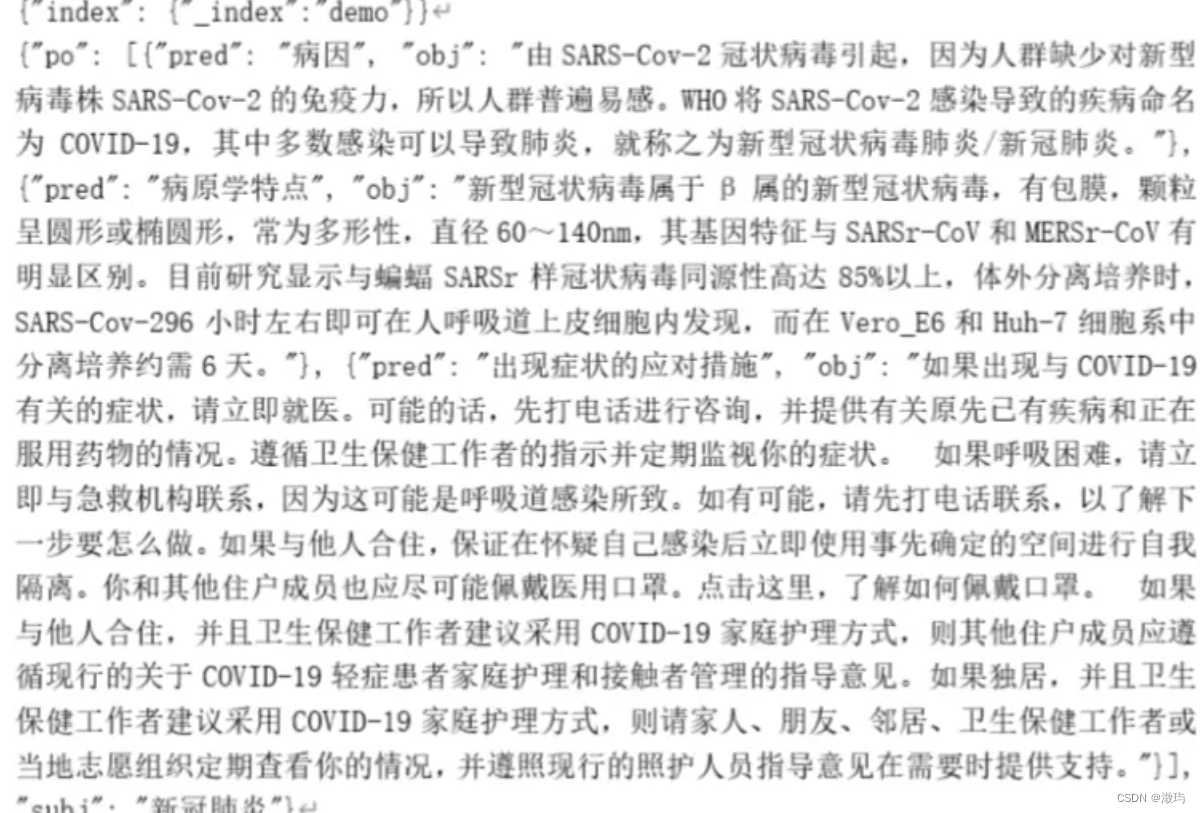
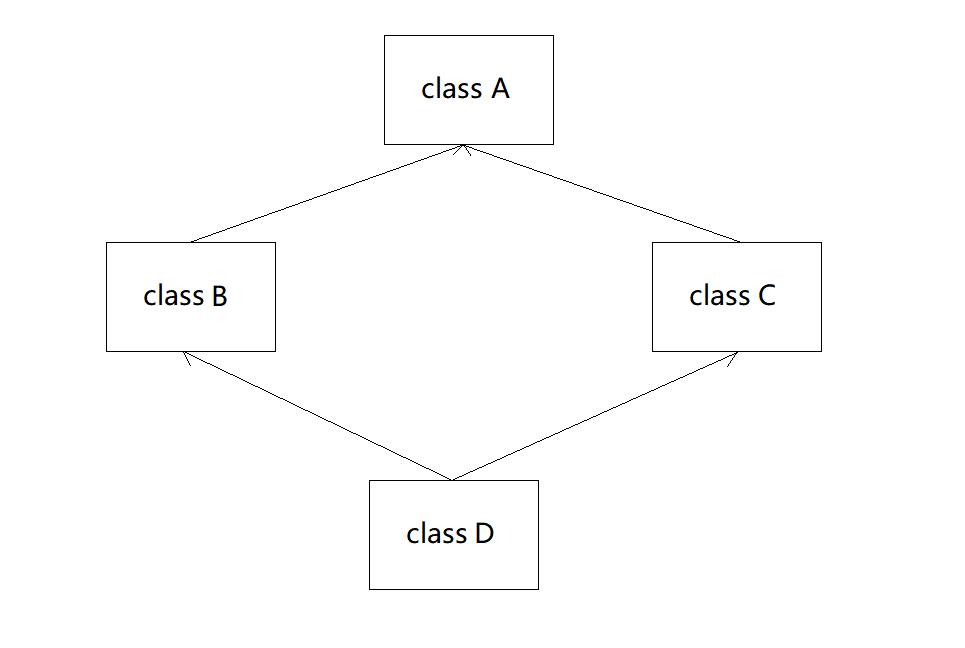




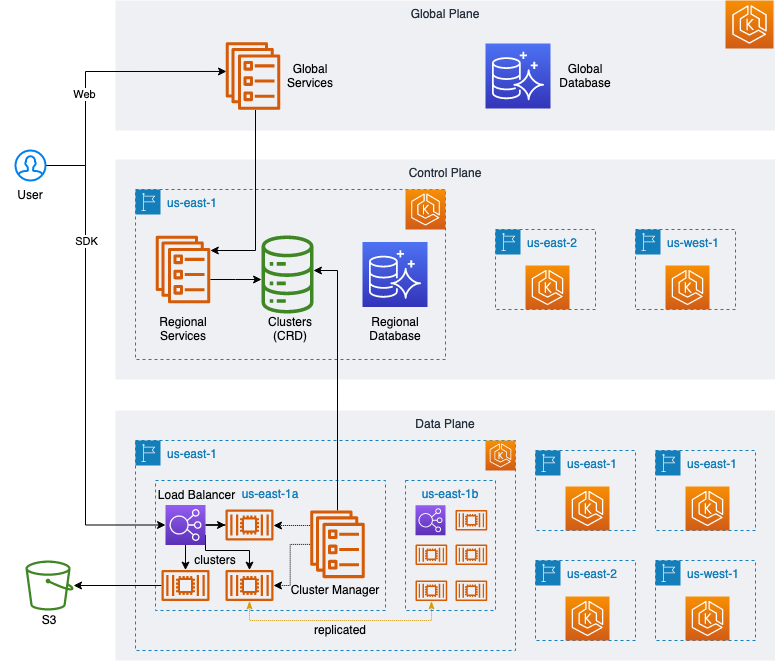


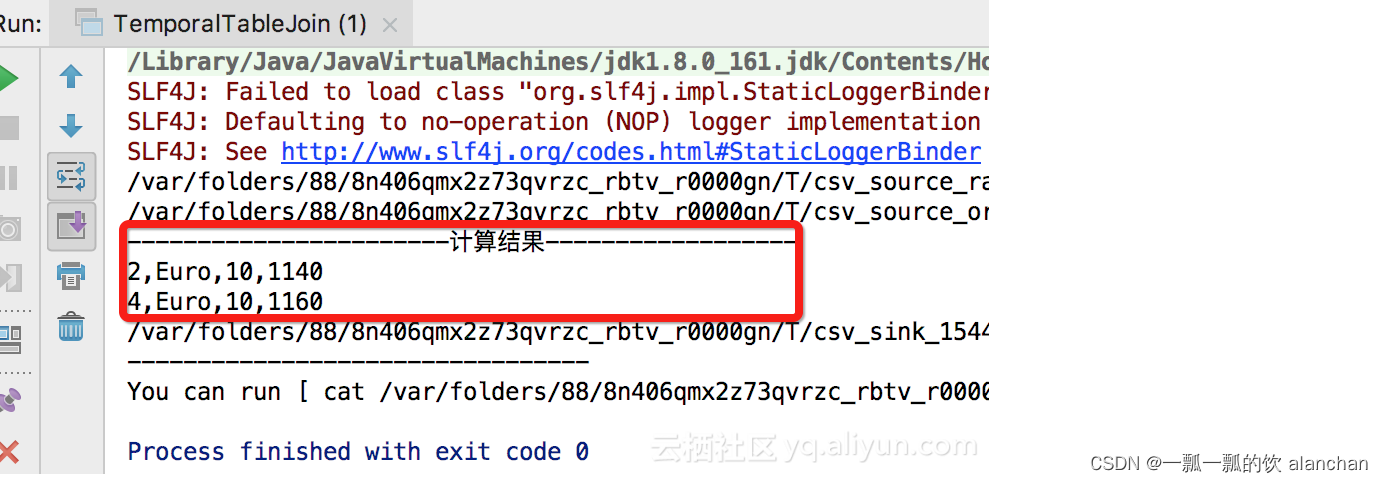

![[区间动态规划] 棋盘分割](https://img-blog.csdnimg.cn/img_convert/d79e95d0b4f3ae40184004feb0bb88ce.jpeg)
